2025-11-11 21:02:44
Hyperscalers believe they might build God within the next few years.
That’s one of the main reasons they’re spending billions on AI, soon trillions.1
They think it will take us just a handful of years to get to AGI—Artificial General Intelligence, the moment when an AI can do nearly all virtual human tasks better than nearly any human.
They think it’s a straight shot from there to superintelligence—an AI that is so much more intelligent than humans that we can’t even fathom how it thinks. A God.
If hyperscalers thought it would take them 10, 20, 30 years to get there, they wouldn’t be investing so much money. The race wouldn’t be as cut-throat.
The key question becomes why. Why do they think it’s coming in the next few years, and not much later? If they’re right, you should conclude that we’re not in an AI bubble. If anything, we’re underinvested. You should double down on your investments, and more importantly, you should be making intense preparations, because your life and those of all your loved ones are about to be upended. If they’re wrong, it would be useful to know, for you could become a millionaire shorting their stock—or at least not lose your money when the bubble pops.
So what is the argument they’re following to believe AGI is coming now, and superintelligence soon after?
Today, LLMs are very intelligent, but you can’t ask them to do a job. You can ask them questions, and they can answer better than most humans, but they’re missing a lot of skills that would allow them to replace a job: understanding the context of what’s going on, learning by doing, taking initiative, making things happen, interacting with others, not making dumb mistakes…
We could define AGI as solving all that: “Now an AI is good enough that you can tell it to do a task that would take a human several weeks of tough, independent work, and they go and actually make it happen.” This is quite similar to the most typical definition of AGI, which says something like “AGI is when AIs will be able to do nearly all tasks that humans can do.” When we reach that point, AIs will start taking over full jobs, accelerate the economy, create abundance where there was scarcity, and change society as we know it.
For some jobs, this will be extremely hard—like a janitor, who needs to do hundreds of very different tasks, many of which are physical, and require specialization in lots of different fields.
For some jobs, it might be much easier. For example, AI researcher:
The jobs of AI researchers and engineers at leading labs can be done fully virtually and don’t run into real-world bottlenecks [like robots]. And the job of an AI researcher is fairly straightforward, in the grand scheme of things: read ML literature and come up with new questions or ideas, implement experiments to test those ideas, interpret the results, and repeat.—Leopold Aschenbrenner, Situational Awareness
The thing that’s special about AI researchers is not just that they seem highly automatable, but also that:
AI researchers know how to automate tasks with AI really really well
AI labs have an extremely high incentive to automate as much of that job as possible

AGI—Automating God Inventors
Once you automate AI researchers, you can speed up AI research, which will make AI better much faster, accelerating our path to superintelligence, and automating many other disciplines along the way. This is why hyperscalers believe there’s a straight shot from AGI to superintelligence. We’ll explore this process in another article, but for now, this leads us to a key reframing of our original question, because a more practical way to define AGI is an AI that’s good enough to replace AI researchers, as this will accelerate the process to automate everything else.
The first step to replacing AI researchers is to be intelligent enough. A key insight on this topic came from one of the most interesting, important, and weird graphs I’ve ever seen:

“Test loss” is a way to measure the mistakes that Large Language Models (LLMs) make.2 The lower, the better. What this is telling you is that predictions get linearly better as you add more orders of magnitude of compute, data, and parameters to an LLM. And we can predict how this will keep going, because it has remained valid over seven orders of magnitude!3
So the jump here would simply be: Let’s just throw more resources at these models and they’ll eventually get there. We don’t need magic, just more and more efficient resources.
The previous graph is from a 2020 paper, but we are witnessing something tangible in the wild akin to that: The length of tasks AIs are doing is improving very consistently.

Every few months, AIs can do longer and longer human tasks at the same success rate.
Here, I took 80% success rate because last time I shared the 50% equivalent, some readers came at me saying “Who cares about 50%, we’ll talk when they’re at 99%!” But if you understand how this works, you’ll understand the progress in length of tasks with 50%, 80%, or 90% accuracy are basically the same.
The reason why an AI might not be able to do a longer task is because mistakes accumulate. If it makes a small mistake in minute 2, in minute 5 it’ll use that early mistake to make another one, and now you have two mistakes. The more of these mistakes you accumulate, the more they snowball.
One way to visualize this is with this graph
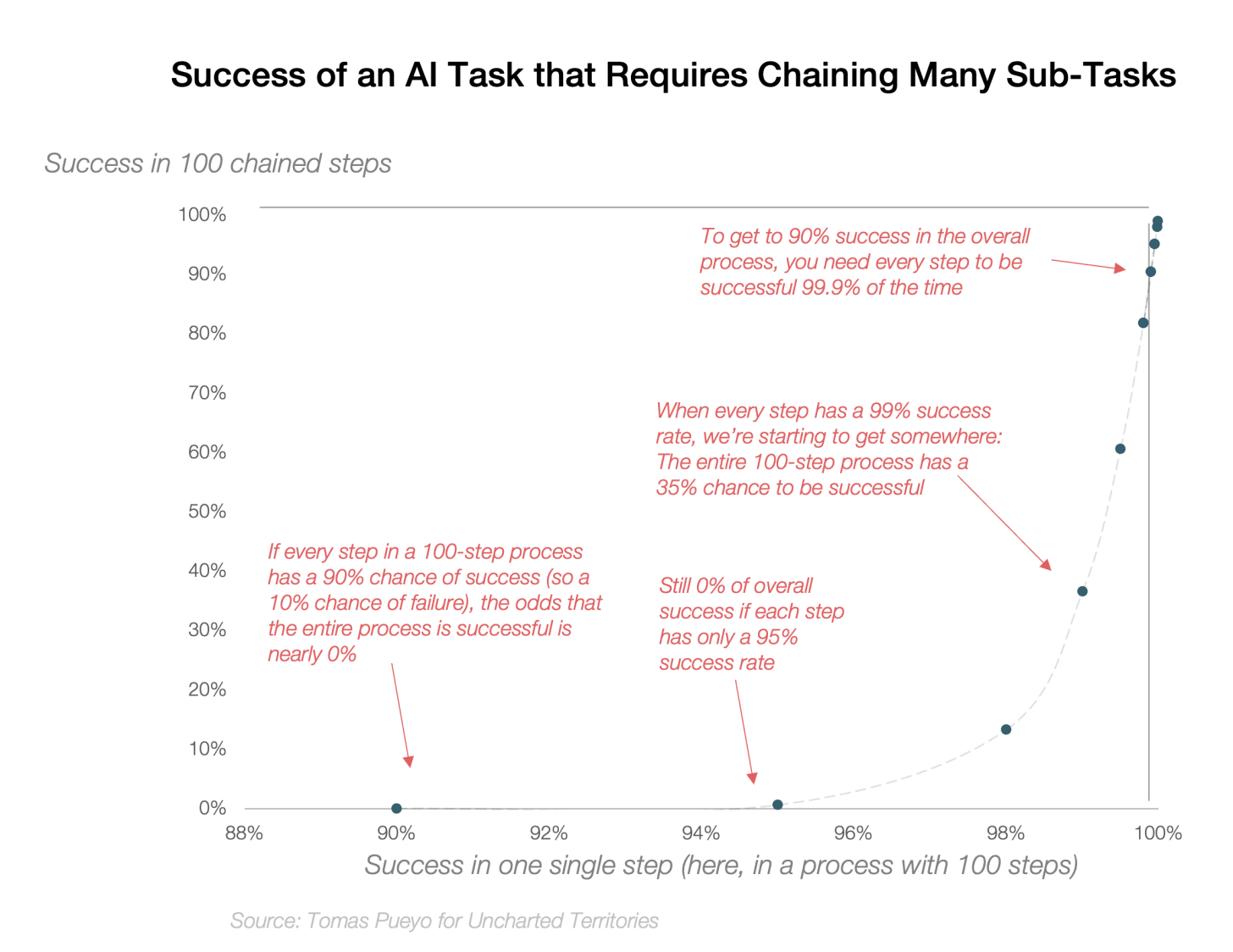
Conversely, if you need fewer steps, you accumulate fewer mistakes.
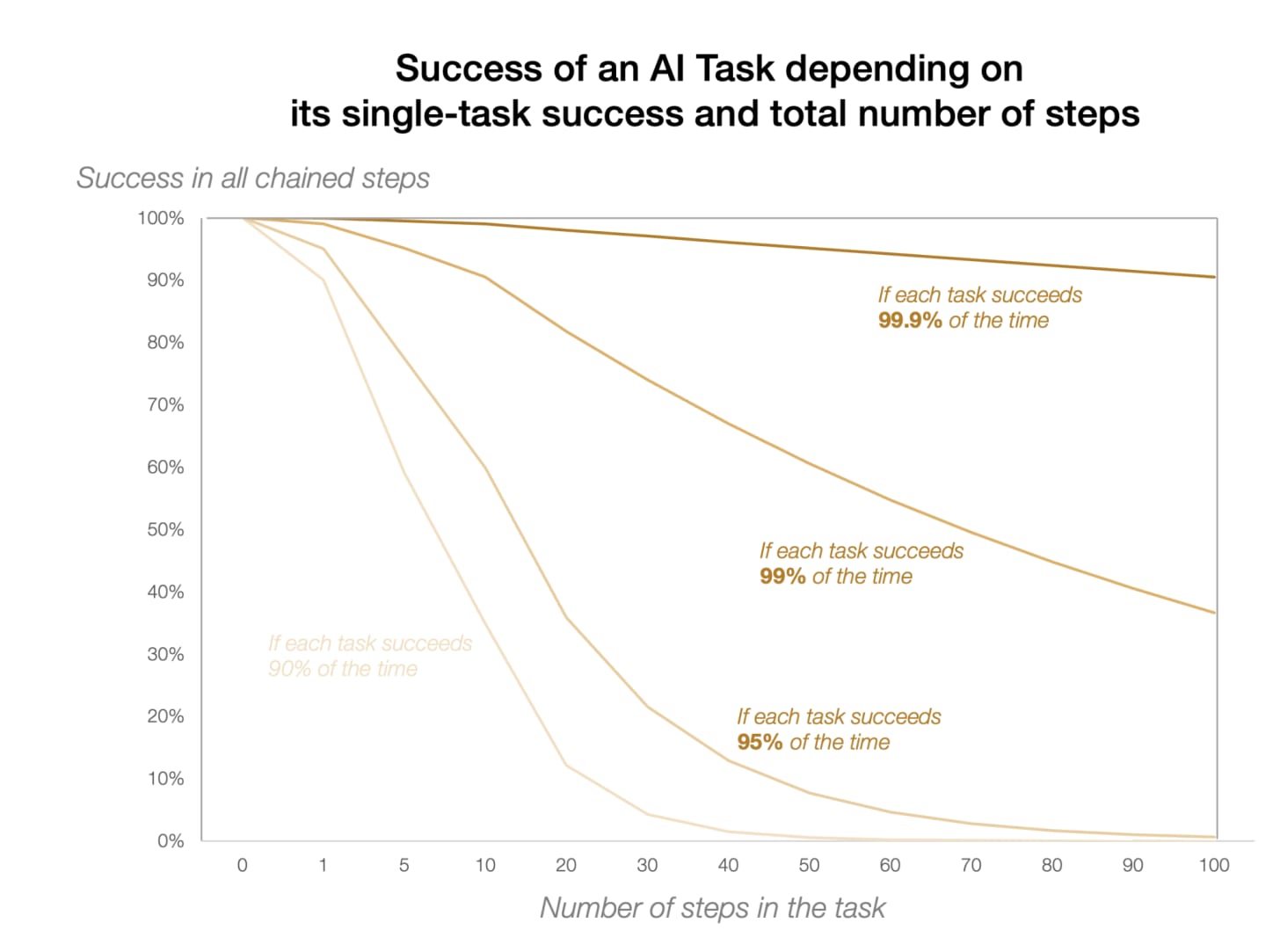
This is why there’s a pretty clear tradeoff between the success rate and the task length in real life:

So if you’re keeping the success rate constant, and your task length is doubling every few months, it means the entire line above is moving to the right pretty consistently every few months.
OK and when will that be enough? Do we need to keep improving for one year? Five years? 100?
It helps to see how AIs perform across domains. What we see time and again is that AIs get to human levels faster and faster, and then surpass them.
Look at how good GPT got in just one year:
The following benchmarks were designed to compare AIs to experts across different fields:
These AI performance evaluations (“evals”) were designed to last a very long time, but they last less and less. The ultimate eval (named “Humanity’s Last Exam”) was meant to last years or decades by making questions extremely hard for AIs. It hoped to remain relevant until AGI. Instead, in less than a year, GPT has gone from a ~3% score to ~32%.
The race to 100% is inexorable.
But you know what I think is most revealing? The evals of AI research replacement. Yes, that exists!

What this graph is telling you is that AIs (in this case, the “very old” Claude 3.5 and o1-preview) beat AI researchers in tasks up to 2-4h, but as AIs and humans are given more time, AI performance increases slowly whereas AI researcher performance goes through the roof. This is why it’s so valuable that AI’s length of tasks keeps improving.
Something similar was discovered in this paper from OpenAI:
It’s not like AIs improving AIs is a pipe dream, they’ve been doing it for years, and every year it accelerates:
Neural Architecture Search (NAS) uses AI to optimize AI neural networks
AutoML automates the entire neural network creation process, including tasks like data preprocessing, feature engineering, and hyperparameter tuning.
AlphaProof (2024) does math at the International Mathematical Olympiad level, generating proofs that inform AI algorithm design.
And of course, coding:
Anthropic: AI agents now write 90% of code!
OpenAI: “Almost all new code written at OpenAI today is written by Codex users”
Google: AI agents write 50% of code characters.
Meta and Microsoft: ~50% next year and 20-30% today respectively
Seeing these data points, one wonders how AI research is not fully automated yet! This Reddit comment shed some light on it:
I and several people I know went from zero to near zero usage of AI a year or two ago to using it everyday. It saves me time, and even more than that it saves me from doing boring work.
Now, did my productivity increase in any way? Not really. I just have more down time. First: I don’t want to advertise my now available time to my manager because they still think in the old way. And I can guarantee that once they find out how productive I can be, I will get more work, not a raise. So I have little incentive to advertise my newly found productivity increase. Second: even if I could do more, most of the things I work for require other people somewhere in the workflow. And those people have not started using AI at work or don’t use it extensively. It doesn’t matter if it took me 5 minutes instead of two days for a document. It will still take an old geezer somewhere 5 days to get back to me after reviewing it.
AI will get better every day, and AI managers will get better too, maybe automating not just tasks, but their orchestration, until both researchers and managers are all automated, and the speed of progress increases by orders of magnitude.
To figure out when precisely that might happen, it’s always good to look at prediction markets. According to Metaculus, we will reach their definition of weak AGI by the end of 2027 (as of writing this article):4
Note that the mode for this prediction is September 2026, in 10 months!
The graph below shows when the market guesses we will reach a more demanding definition of AGI:
AGI in 2033. Here again the mode is much earlier, April 2029, in 4 years
The definition of AGI in this second market includes robotics, though, which I think is the reason why the market believes it will take much longer. Without robotics, I believe the market would predict this date to arrive much faster.
A key argument that Aschenbrenner makes to conclude that AGI will happen within the decade is because we’re going to increase our machines’ ability to think much faster now than in the future:
The ramp up in AI investment we’re making is unsustainable. We can’t keep dedicating more and more money to AI forever.
We’re finding the low-hanging fruits of computer and algorithm optimization.
These two together suggest that, if we are to find AGI, it’s either in the next few years, or it will take dramatically longer.
Matthew Barnett illustrated it visually:
Why does all this matter? What we’re saying here is that we’re just a few years away from AGI, and that’s a key reason why hyperscalers are spending so much money on AI. If this were true, then hyperscaler leaders should manifest their belief that AGI will be reached in the next few years, probably before 2030. Do they?
Elon Musk thinks AGI will be reached at the end of this year, or the beginning of next year:

Dario Amodei, CEO of Anthropic, thinks it’s going to be in 2026-2027.
“We will just fall short of 2030 to achieve AGI, and it’ll take a bit longer. But by 2030 there’ll be such dramatic progress… And we’ll be dealing with the consequences, both positive and negative, by 2030.”—Sundar Pichai, CEO of Google and Alphabet
Over the next 5 to 10 years, we’ll start moving towards what we call artificial general intelligence.—Demis Hassabis, CEO DeepMind.
Sam Altman, CEO of OpenAI, believes the path to AGI is solved, and that we will reach it in 2028.
We’re closer than anyone publicly admits.—Sam Altman
So they think it’s coming in 1-10 years, with most of them in the 2-5 range.
The arguments to claim we’re about to make gods are:
AI expertise is growing inexorably. Threshold after threshold, discipline after discipline, it masters it, and then beats humans at it.
We’re now tackling the PhD level.
In the current trajectory, we should reach AI Researcher levels soon.
Once we do, we can automate AI research and turbo-boost it.
If we do that, superintelligence should be around the corner.
How soon should we expect to reach AI Researcher level?
The past progression suggests it’s a matter of a few years.
We can see this happening, with parts of the AI workflows being automated as we speak.
Markets are consistent with this belief.
What hyperscalers say and what they do is consistent, too.
We’re about to increase effective compute so much that, if it doesn’t happen in the next few years, it might take decades.
You can have two types of disagreements with these statements:
Effective compute won’t keep increasing as it has until now
Even if it does, it won’t be enough to reach AGI
Let’s focus on them in the coming articles and answer the following questions:
Can our compute keep getting better as fast as it has in the past?
What’s the relationship between that and the AI bubble? Does that clarify whether there’s an AI bubble?
Can algorithms keep getting better as fast as they have in the past?
What about the data issue?
What other obstacles are there to AGI?
If we do reach AGI, will we reach superintelligence? Will we reach God?
If we do, what happens next?
As we discussed in the previous article, another is simply that revenue justifies it. But these things are entangled: If we reach AGI, of course money will justify massive amounts of investment, since it will take over huge parts of the economy.
LLMs are really just word prediction machines. Here, test loss measures how well the LLM can predict the next word in a text it has never seen.
This is so weird to me because it’s a sign of how intelligence can emerge in animals, and especially human brains. They’re just a matter of having enough neurons and enough connections between them. It means intelligence emerges, rather than requires delicate design. It makes humans much less magical than people might think. We’ve just stumbled upon the first path to intelligence that nature found, and it found it not because it was especially difficult. It just had to optimize for intelligence for long enough to surf down these lines.
This AGI definition is easier to achieve than ours, but it’s pretty telling we’re getting into the realm of what was defined as AGI a few years ago. The definition in Metaculus: “We define AGI as a single unified software system that can satisfy the following criteria, all easily completable by a typical college-educated human.
Able to reliably pass a Turing test of the type that would win the Loebner Silver Prize.
Able to score 90% or more on a robust version of the Winograd Schema Challenge, e.g. the “Winogrande” challenge or comparable data set for which human performance is at 90+%
Be able to score 75th percentile (as compared to the corresponding year’s human students; this was a score of 600 in 2016) on the full mathematics section of a circa-2015-2020 standard SAT exam, using just images of the exam pages.
Be able to learn the classic Atari game “Montezuma’s revenge” (based on just visual inputs and standard controls) and explore all 24 rooms based on the equivalent of less than 100 hours of real-time play
2025-11-04 20:42:52
The Financial Times has written about it. The Economist. The New York Times. The Atlantic. It was a big theme at a few recent conferences I went to. The investment community thinks we’re in a bubble:
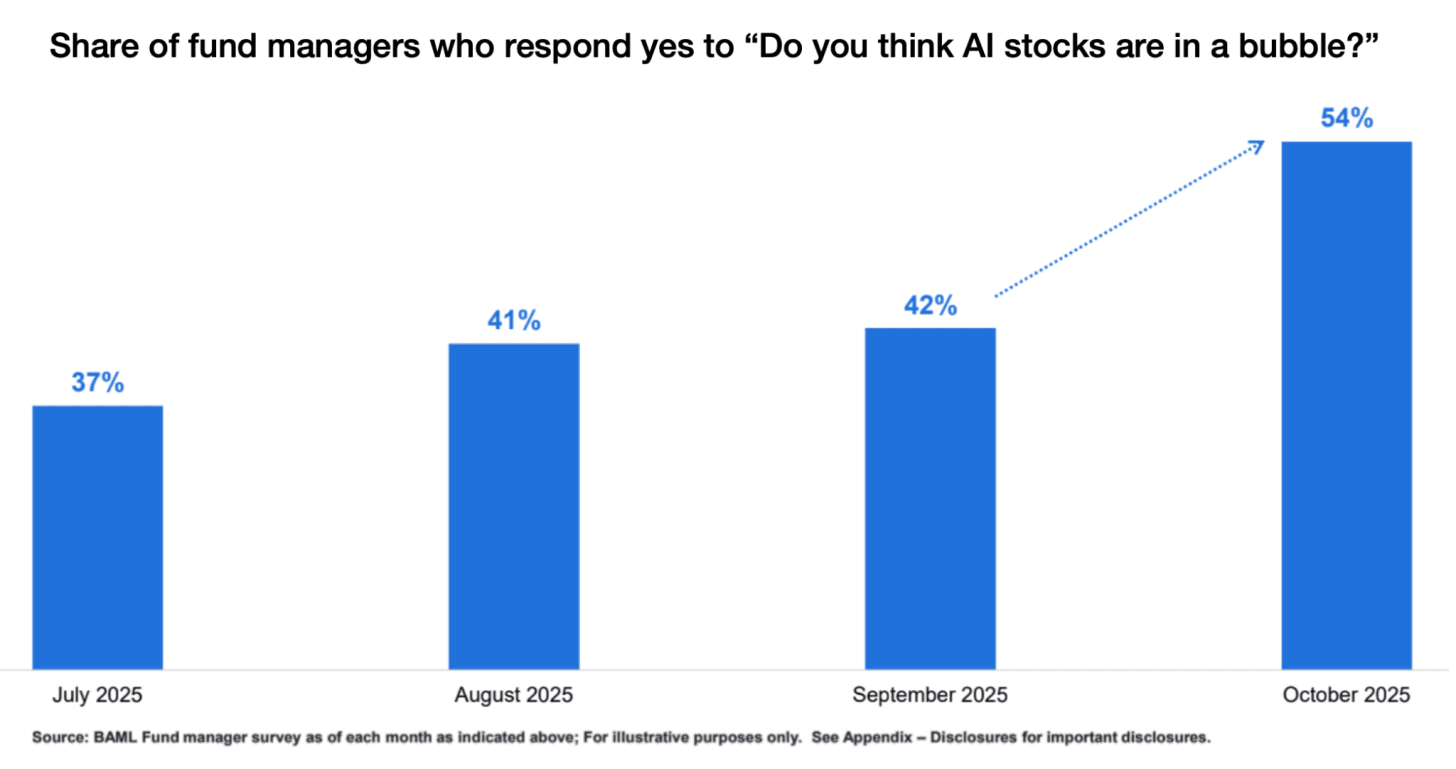
The fear is that we’re in a similar situation to the tech bubble in 2000-2001, or the railroads in the late 19th – early 20th century. In both cases, the investment (in Internet cables, websites, railroads) was amazing in the long term, but there was initial overinvestment. When early demand didn’t materialize, lots of companies went down and investors lost their money.
A market correction of the same magnitude as the dotcom crash could wipe out over $20trn in wealth for American households, equivalent to roughly 70% of American GDP in 2024. Foreign investors could face wealth losses exceeding $15trn, or about 20% of the rest of the world’s GDP. For comparison, the dotcom crash resulted in foreign losses of around $2trn, roughly $4trn in today’s money and less than 10% of the rest of the world’s GDP at the time.—Gita Gopinath on the crash that could torch $35trn of wealth
This is what happened to top tech stocks in the dotcom crash:
If you invest in stocks and like having money, you might not want your portfolio to look like this. So is this happening now?
They’re everywhere if you pay any attention.
If you take a huge step back, we should be in a recession. Interest rates went up dramatically after COVID, there’s a trade war around the world, the European economy is in tatters because of overspending on social programs, the high cost of energy, and competition from China. Yet the economy is booming and the stock market with it.
This is single-handedly driven by the impact of AI, which accounted for 85% of the gain in US stocks so far in 2025!1 AI companies now make up half of the S&P500!
This viral chart puts it in context:
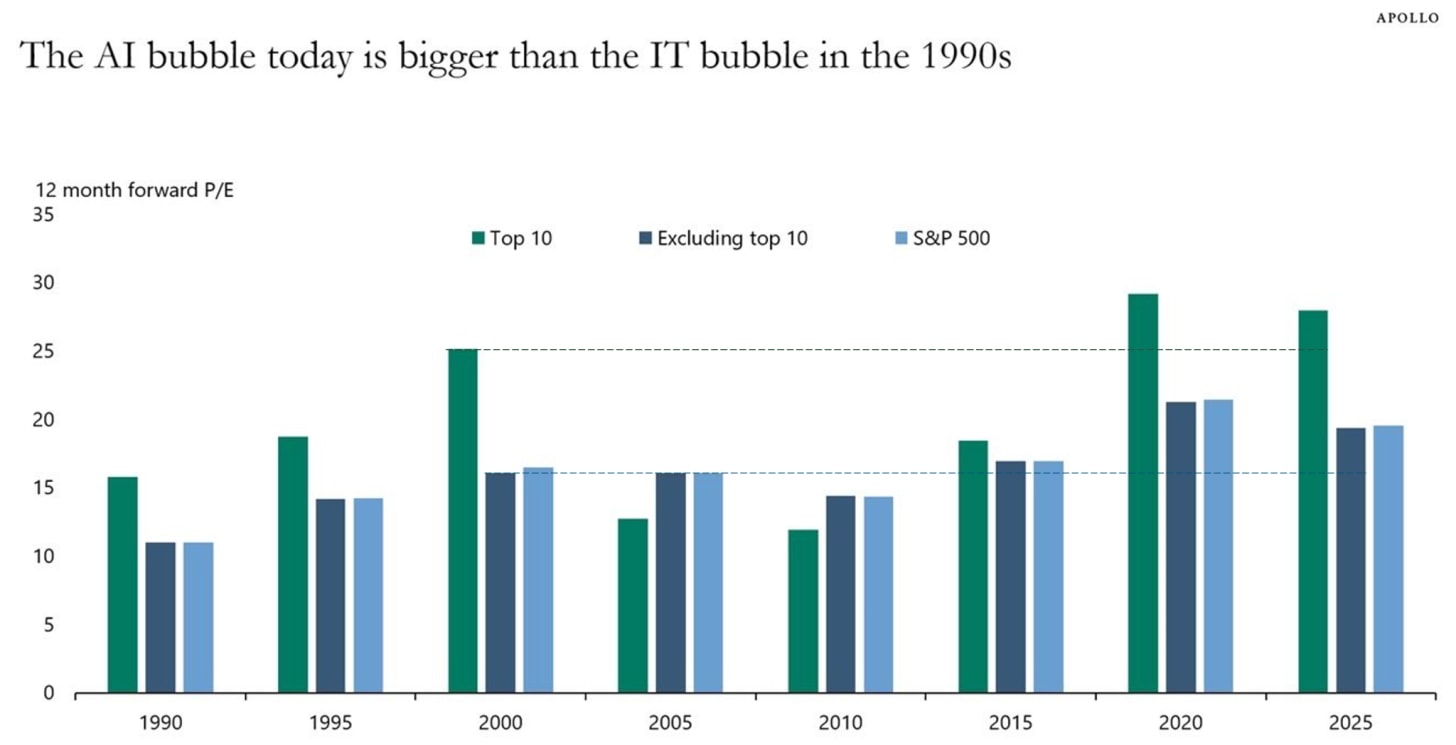
From peak (2002) to trough (2006), the S&P lost 64% of its value. Yet the stock market is more expensive today (vs its actual earnings) compared to the equivalent numbers in 2000, just before the dotcom burst.
If instead of P/E ratio you look at price-to-book value (the price compared to the value of the company in the books; its assets minus liabilities):
People love comparing the evolution of stock prices:
Warren Buffett is smelling the blood and is accumulating cash, anticipating a buying spree when the markets crash.
He’s been selling stocks for four straight years to build up this war chest:
The outsized valuations Buffett is preying on are based on the promise that AI will make these companies a ton of money. For that, they need to invest a lot upfront in chips, data centers, servers, software… This is so much investment that ~45% of the US economy’s growth so far in 2025 is due to AI build-up! A lot of it comes from the top 4 biggest AI companies.
They are not the only ones investing.
There’s a projected $1.5T debt for AI data centers by 2028. Together, all these investments account for a higher share of GDP than in the dotcom bubble!
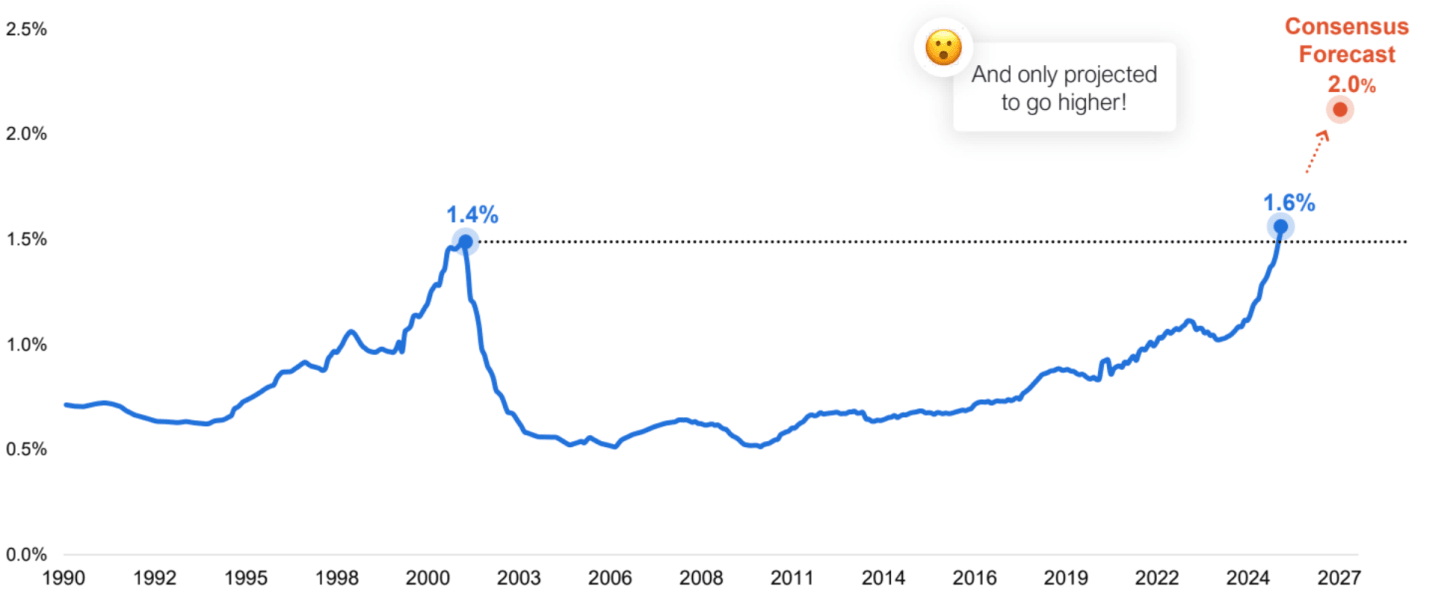
It’s not yet at the level of railroads or electricity, but if it keeps growing as planned, it might reach ~4% of GDP, competing with the electrification craze.
But also, everybody is investing in everybody else.
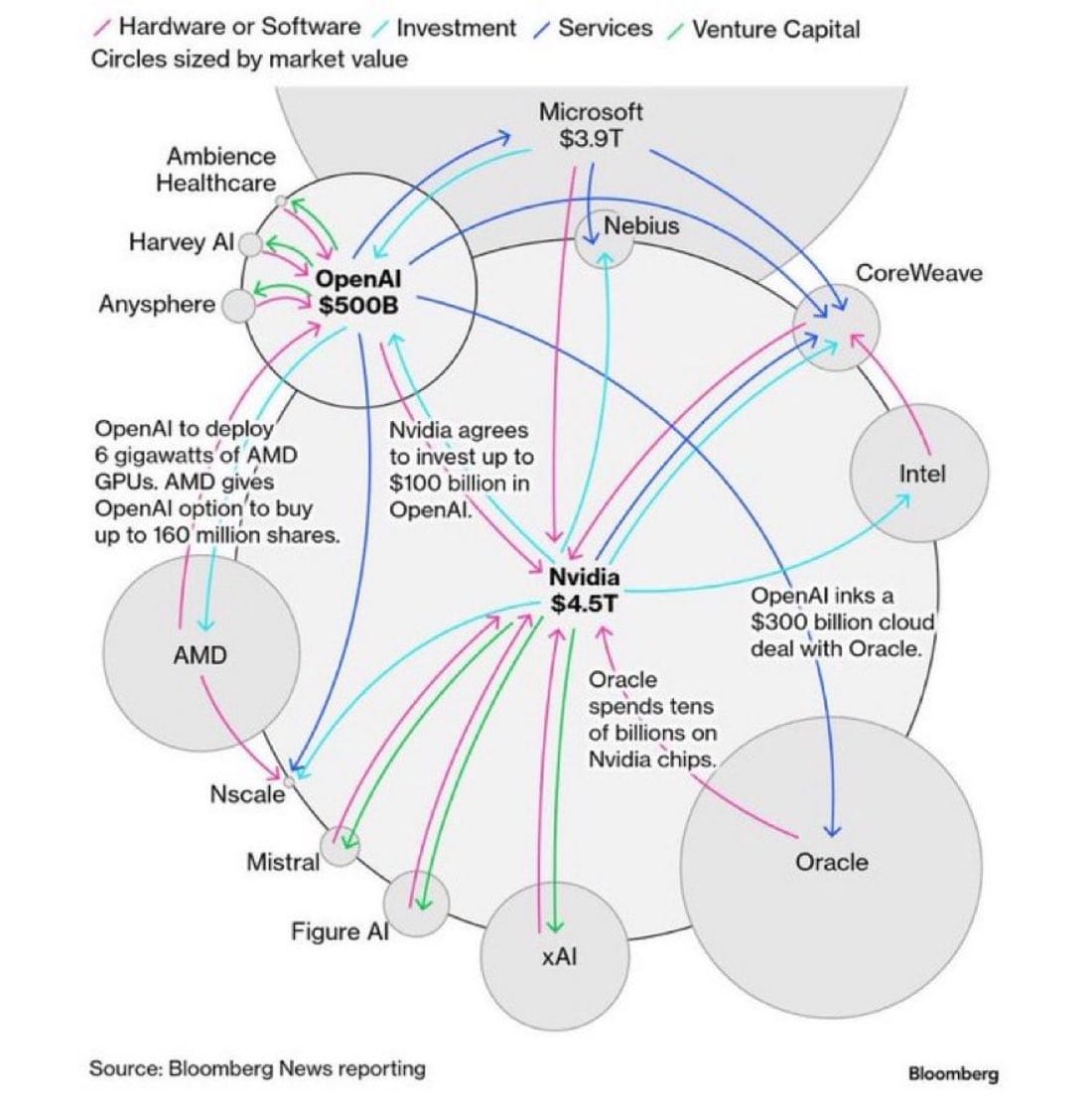
The fear here is that companies might be inflating valuations by investing in and spending with each other. There’s also the fear that if one fails, many others might, too.
So are all these investments supported by sound financials?
How can a company with $13B in revenue make $1.4T of spending commitments?—Brad Gerstner, All Things AI podcast
Sam Altman says OpenAI makes more than $13B, and revenue is growing fast, but still. Only 1% of spending commitments are covered by revenue?
Most of what we’re building out at this point is the inference [...] We’re profitable on inference. If we didn’t pay for training, we’d be a very profitable company.—Sam Altman
What this means is that the initial investment costs are so humongous that OpenAI, the company that makes the most money from end consumers of AI, loses money. In fact, it’s valued at $500B with no profits expected for 5+ years! The company is burning about $12B per quarter right now, on 700M weekly users.
OpenAI is burning $12B per quarter
And what happens if chips are outdated in 3-5 years? Wouldn’t that be a way to burn trillions in value?
All of this would be OK if customers were seeing a lot of value in AI and couldn’t stop buying more and more: OpenAI and its peers could learn how to spend its money better over time, amortize their huge investments over decades, and print money. But this doesn’t seem to be the case
95% of organizations are getting zero return in their GenAI investments.—State of AI in Business, MIT.
If end customers like Unilever or Walmart don’t see a return on their investment into AI companies like OpenAI or Anthropic, will they keep investing? If they don’t, what will happen with the hundreds of billions of investment commitments the AI companies have with the likes of NVIDIA and Coreweave?
That’s why it’s a worrying sign that corporate AI adoption remains low and is shrinking!
Remember that the big four tech companies are investing hundreds of billions per year in their AI build-up. They would need trillions in revenue to make this back!
This reminds me of Internet infrastructure.
By the early 2000s, telecom companies had raised almost $2T in equity and $600B in debt, mostly to build over 80M miles of fiber optic cable in the U.S. alone. By 2005, as much as 85% of those cables were still unused (“dark fiber”). This led to plummeting bandwidth prices and eventually, serious financial losses and bankruptcies in the telecom sector.—Akshat Shrivastava, checked here
The supply was built too far ahead of the demand. Worryingly, Microsoft is canceling data center leases due to the fear of oversupply. They are specifically targeted to limit OpenAI’s training of better AIs.
Maybe you could imagine a return to reason, where players realize they might lose trillions, and decide to lower investments and increase prices? But this will not happen here because these are the biggest companies in the world fighting to be the first ones to create a god, and harness all the power and value that come from it. Luckily for them, they’re already making money hand over fist, guaranteeing that they can keep financing this at steep losses for a long time.

So hold on a second: The bulk of GDP growth and market exuberance comes from a handful of companies with circular investments that lose money servicing every customer. Meanwhile, these customers don’t understand these AI products well enough to make them useful, so their adoption has slowed down, but this whole castle is built on estimates of revenue growing exponentially?! Which must happen through more customers, because more revenue per customer might be hard, as all these companies are competing on price, and their pockets are so deep they can keep pushing prices down for decades?
Is it a bubble then? Here’s why I don’t think it is.
2025-11-02 00:47:18
Traducción al español la próxima semana. Suscríbete para recibirlo.
Javier Milei’s party just won Argentina’s legislative elections. Why? How can we understand his policies? Will they lead to Argentina’s return to wealth and greatness? Or will they lead it straight back into yet another cycle of mayhem? Should he do anything differently? To answer these questions, we need to understand why Argentina is poor today.
But doing so is one of the hardest tasks in economics. Argentina’s poor performance is among the most discussed topics in international economics. So I have tried to synthesize what research tells us, and I found an illuminating way to doing it was comparing the development of Argentina with those of Japan, Taiwan, South Korea, and China (covered here), because all these countries did very similar things but ended up with dramatically different outcomes. This helps us isolate the few differences that probably caused Argentina’s demise. In any case this is such a complex issue that I’m certain to have made mistakes. If you find any, please correct me in the comments or by responding to this email.
Around 1900, Argentina was 2x richer than Japan, and over 4x richer than Taiwan, South Korea, and China. But all these countries are now richer than Argentina. Why?
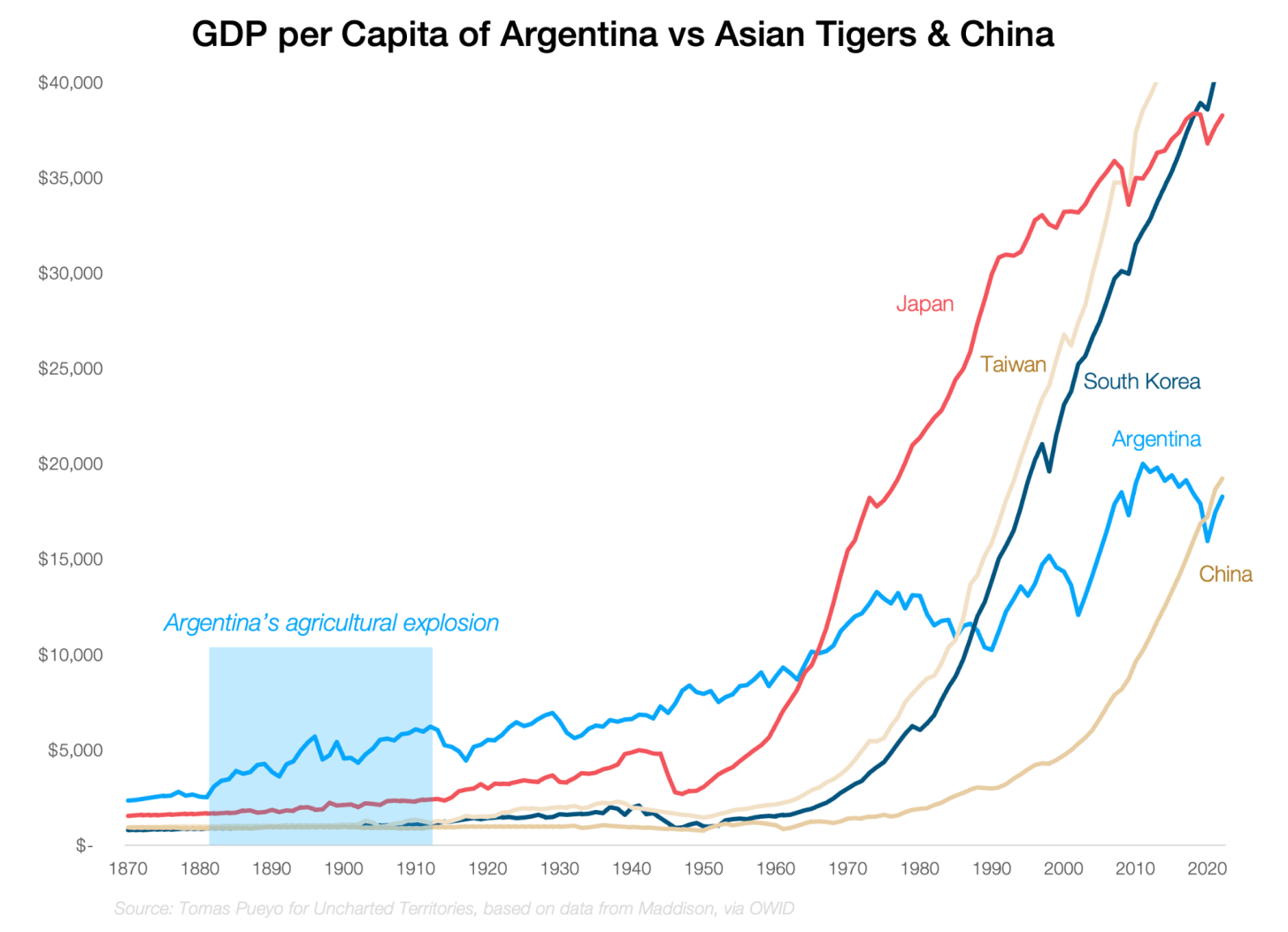
This is a much more interesting story than it appears, because the similarities between these countries’ economic policies are uncanny. But there are a few crucial differences that caused the Asian countries to grow while Argentina stagnated. So let’s look first at what the Asians did, and then compare with Argentina, to see where everything went wrong and why.
I explained it in detail here, but here’s the summary.
The land in Taiwan, Japan, and South Korea was concentrated in few hands. The first thing they did after WW21 was to redistribute it. This gave many people jobs and increased farm productivity, because farmers now owned the farm and its products, so they tried to improve both: They invested in machinery, better fertilizer, better grain, they didn’t overwork the land…
As farm productivity increased, these farmers were able to save money. Productivity increased enough to feed the country. The governments taxed farmers, but also frequently subsidized them through minimum prices for their crops, help procuring fertilizer, seeds… There was little food export, but what existed was heavily controlled and taxed.
Thanks to this, each country developed a broad base of farmers, increased their savings, and earned foreign income.
Once farming worked, these countries started redirecting the surplus to industries to develop them. They picked a few key industries and supported them in many ways:
They frequently applied import taxes to the foreign competition of protected industries. This is called infant industry protectionism.
They reduced their taxes.
They gave them cheap loans.
They got import licenses so they could import, and do so with limited taxes.
Crucially, they only did this to the companies that were growing fast and were able to compete internationally. Those that couldn’t compete stopped receiving cheap loans and were pushed to merge or fail.
Where did the money come from for these cheap loans? From the farmers (and other citizens), who couldn’t invest their money wherever they wanted. Real estate and stock markets were not accessible to them, and neither could they freely place their money abroad. They were forced to put the money in the bank with low interest rates. That’s the money that was then lent to industrial companies.
Also, the exchange rate was kept low, and inflation suppressed:
Exports were left untaxed, so there were a lot of exports. They brought foreign currency to their home countries (usually USD). They spent some in international markets (fertilizer, seeds, machinery…), and the rest they sold to buy local currency.
The central banks bought the USD. They printed local currency to buy it.
This would have led to inflation, so they sterilized this by emitting low-interest debt and forcing banks to buy it.
Foreign investment was limited. Since foreigners have foreign currency and sell it to buy local currency, they tend to appreciate the local currency. By limiting their investments, they limited this local appreciation.
Wage growth was kept low. Trade unions were pushed to accommodate this. This kept inflation at bay.
We saw in our two previous articles that Argentina’s geography is outstanding, and the country capitalized on it in its 1880-1910 agricultural boom:
Farmland expanded quickly
Many cattle ranches were replaced with crops, with the help of rapid mechanization and immigration2
But here’s the original sin of Argentina: Farms remained highly concentrated.
This didn’t impact land productivity too much at first, because the landowners had an incentive to maximize their production and thus their exports.
However, since land was so concentrated, there wasn’t a broad base of farmers who could benefit. A few landowners gained outsized economic, social, and political power.3
This rising inequality caused a political backlash that didn’t happen in the Asian Tigers. This political pressure pushed governments to tax farming in a less productive way than Asian Tigers had.
Recall how Asian Tigers also taxed agricultural exports, but there were few, and they used most of that income to reinvest in farms. The biggest redistribution from agriculture to industry was indirect: by forcing farmers to save at the bank their wealth, which was then lent to industries.
Instead, Argentina simply taxed agricultural exports. For example, the IAPI (Instituto Argentino de Promoción del Intercambio) had a monopsony on agricultural exports (it was the sole buyer by law).
In the 1950s, Argentina’s government bought all Argentinian beef and grain from farmers at a price well below market: up to 60-70% cheaper than world market prices. Then, it sold them in the international markets at a much higher price, which had increased thanks to higher demand after WW2. It pocketed the difference. On average, that was 44% of revenues from wheat between 1946 and 1951, and 40% for corn.
These taxes went down over time, but have been a recurring reality in Argentina’s history.
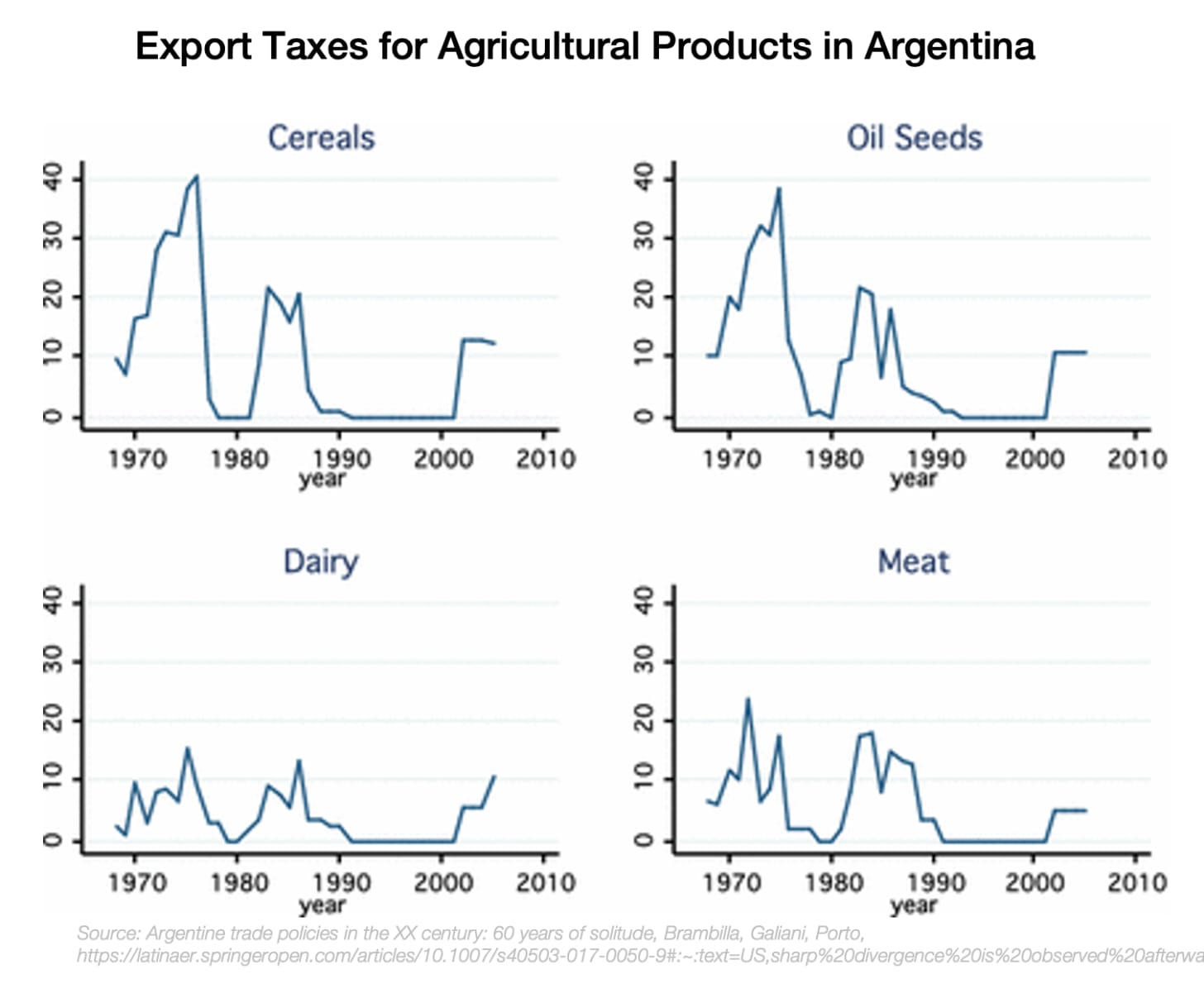
Heavily taxing exports is much worse than what the Asian Tigers did, because it disincentivizes investment. Imagine that you can produce a ton of wheat at a cost of $80, and you can resell it internationally at a price of $100. This gives you a nice profit of $20, which you can use to reinvest in expanding the business. But if the state taxes you at 30% of revenue, now you can only sell your wheat for $70. Suddenly, your entire operation is unprofitable, and you go bust. Even if your cost was $60, this is bad: You go from a margin of 40% to 14%, so many previous investments become unviable.
This reduces both production (and so exports), and investment. Indeed, Argentinian agriculture suffered from this, which we can see in the graph of wheat & corn productivity from before the export tax was introduced during Peron’s first term, when yields were still competitive:
How many Japanese, Taiwanese, and South Korean industrial brands do you know?
How many Argentinian ones?
Yep. The Asian Tigers succeeded where Argentina failed. Why?
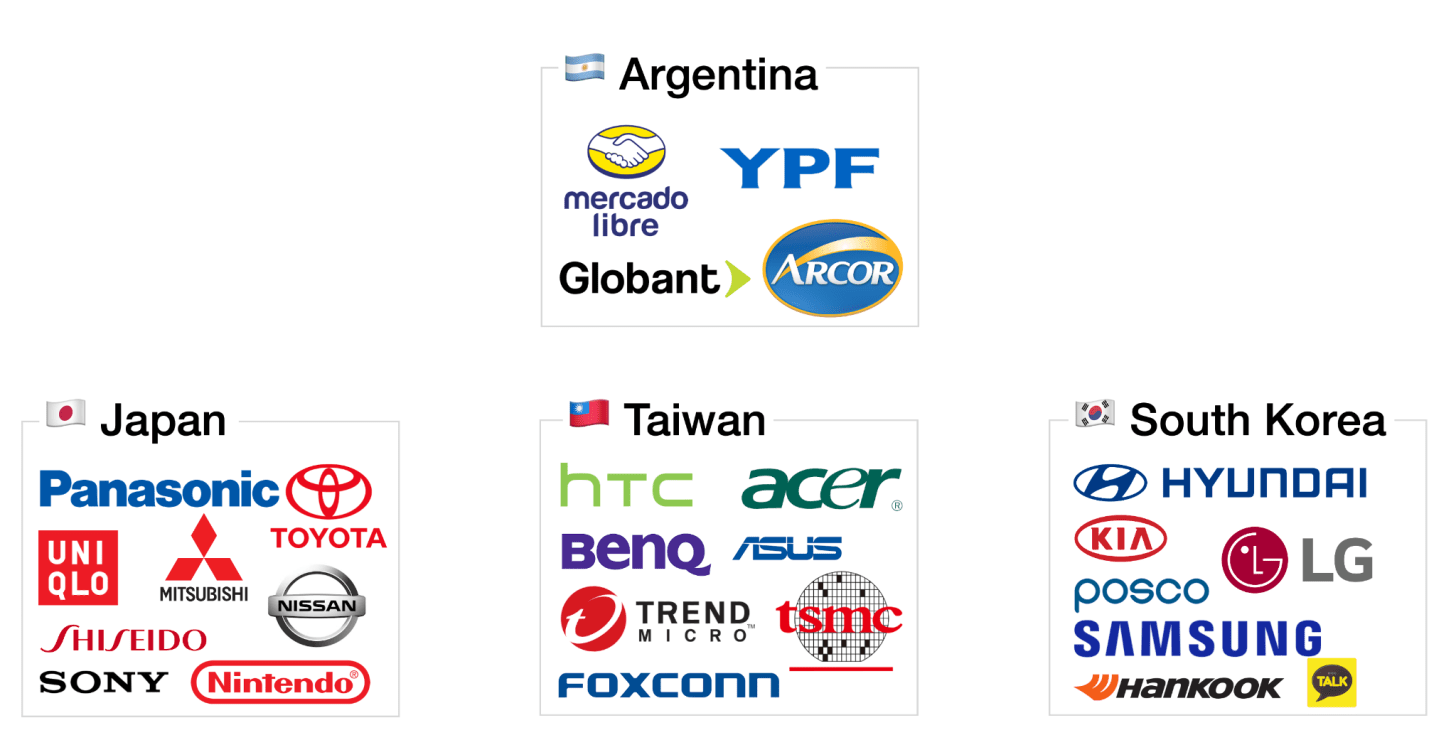
Recall how the Asian Tigers protected their infant industries with cheap loans, low taxes, import taxes against the competition, etc? Argentina did something similar, import substitution. But with some crucial differences that changed the outcome entirely.
Argentina made a lot of money through agriculture, but only in booming international markets. During the world wars and the Great Depression of 1929, demand crashed, and with it commodity prices and Argentinian incomes. Without foreign currency, the country couldn’t afford imports anymore during these hard times, which meant no more manufactured goods. So it concluded it had to produce stuff by itself—substitute imports with local industry.
Notice the subtle difference here, though: This was not about increasing industrial exports. It was about replacing industrial imports. This changed the mindset completely, from one where local champion companies had to aggressively improve their productivity to compete abroad, to one where local champions were protected from abroad.
Why does this matter? Because exports are impossible to fake. If you win in world markets, it’s because you’re the best. But if you win in local markets… You’re simply good at getting Daddy State to protect you and your lack of productivity against internal and external competitors. The Argentinian state used:
Import barriers, such as tariffs or quotas against international competitors
Cheap loans to local industrial companies
Different exchange rates for agricultural exports and industrial imports, so that industries could buy at a discount
State-owned companies
Subsidies, such as below-cost electricity or train transportation
Tax exemptions
All of these tools were similar to those used by the Asian Tigers. The difference was how they were used.
This is by far the most important difference. These aids were not conditional on winning in global markets like in Asia, so most of these companies simply stayed in the local Argentinian market, protected from competition. They kept prices high, and lived off the rents.
Meanwhile, the rest of the country had to pony up more cash to buy the same appliances that would be better and cheaper from abroad. Terrible.
Export discipline has another advantage, which is that an exporting company has a huge potential market. This is especially important if there is a high upfront cost. Imagine you want to make steel. You need a massive factory to do it, so you better have a market that can buy millions of tons to amortize the upfront cost. If your market is small—like the Argentinian market—you will never have enough customers for economies of scale, and your costs will always be too high.
Car factory costs in Argentina, Brazil, and Mexico were about 60% to 150% higher than in the United States.—Import Substitution in Latin America, Baer
The paper industry (excluding newsprint) had 292 plants of which only 25 had a capacity of 100 tons daily, which is considered the minimum economic size. In the chemical industry, too, there are a great many instances in which there is a wide gap between the plant sizes most frequently found in the region and the sizes constructed in the industrialized countries.—Import Substitution in Latin America, Baer
Each time you give a cheap loan, subsidize a cost, or increase some import tariff, it costs the state money. They’re like a tax on everybody else. So the state needs to be extremely thoughtful about it. It can’t prop up local players in every industry, it needs to pick the few key industries it’s going to support, and focus all its resources there.
Usually, this is done in industries that are core for the future of the country. In the case of Japan and South Korea, they both went for steel as a key input to then produce heavy industries such as car companies. Now you know Toyota, Nissan, Mazda, Subaru, Hyundai, Kia… But you might not know the powerful Nippon Steel or the South Korean Hyundai Steel4 or POSCO.
Within the industries Argentina decided to play, it should have found the winners and supported only those, pushing the others to die or merge. It’s easier to support one big company than a bunch of small ones. For example, Argentina had over a dozen car companies,5 which is good to start but you need them to merge!
In Argentina, excessive diversification, unused capacity, large inventories because of import controls, and difficulties in obtaining outside finance explain the high price level in the heavy electrical equipment industry.——Import Substitution in Latin America, Baer.
It’s not enough to pick a few industries. The focus should be on only the ones where Argentina had a competitive advantage. You can’t be good at everything. Pick your battles. For example, given its agricultural might, could it have pushed for agricultural manufacturing companies? It had Vassalli, Senor, Pauny, Zanello, and Araus.6 Could it have produced the Argentinian John Deere with more support?
What other industries could Argentina have picked? Meat-packing and cold-storage processing? Railways? Shipbuilding? Metallurgy, nuclear, precision instruments?
Instead, it supported electronics companies like BGH, Newsan, SIAM, or Philco. But electronics is a very low-margin industry in which Argentina has no competitive advantage and you need exports to reach sufficient scale to bring down costs. As is, Argentinians had to spend much more to get their worse TVs, and in the process spend up to 1% of GDP subsidizing the industry!7 Another example is textiles and apparel. Do you really want to compete with the Indias and Bangladeshes of the world and their rock-bottom wages and no margins?
Speaking of wages, the Asian Tigers kept wages low for a long time to keep overall production costs low. They did so, among other things, by working with trade unions, who understood that they needed a long period of low wages to become competitive, and only then could they increase wages.
Argentinians held the opposite view. They grew up experiencing high inequality from agricultural exports, so they wanted to tax them to redistribute wealth to the people. Industrial production (and exports, when they existed) were seen as yet another source of money to tax. The exact opposite mindset as in Asia, with resulting higher wages, higher costs, less competitiveness, and a lack of global champions.
Employers were forced to improve working conditions and to provide severance pay and accident compensation, the conditions under which workers could be dismissed were restricted, a system of labour courts to handle the grievances of workers was established, the working day was reduced in various industries, and paid holidays/vacations were generalised to the entire workforce. Perón also passed a law providing minimum wages, maximum hours and vacations for rural workers, Sunday rest, paid vacations, froze rural rents, presided over a large increase in rural wages, and helped lumber, wine, sugar and migrant workers organize themselves. Perón established two new institutions that increased wages: the “aguinaldo” (a bonus that provided each worker with a lump sum at the end of the year amounting to one-twelfth of the annual wage) and the National Institute of Compensation, which implemented a minimum wage and collected data on living standards, prices, and wages.
From 1943 to 1946, real wages grew by only 4%, but from then to 1948 (under Perón), they grew by 50%.
Subsidies on energy, food, housing, and transport had the same effect of increasing effective compensation.
Let’s take housing: The Perón government built hundreds of thousands of houses. That sounds good, but there are many problems with this:
We can see this as everybody in the country putting money aside to buy a house for a few. Who gets those houses? Friends of politicians? Are the recipients the most deserving? Those who need the houses the most?
Where does this money come from? If it’s not a sustainable source (hint: agricultural booms and busts are not), it’s a recipe for disaster.
The cost of building additional housing goes up (since the government is now outbidding the private market for builders), making it harder for everybody else to get a home. When you want everybody to get a home, the first thing you should do is focus on lowering all types of building costs.
All these things (housing, holidays, retirement…) are great objectives for a country to have, but it was too early to have so many. Employees can only earn as much as they produce. When they are not very productive (that is, early on in a country’s path to development), what these measures achieve is increased costs for industries, to the point where they become uncompetitive and either disappear or must be subsidized by the government—that is, the government taxes the productive parts of the economy (here, agriculture) to subsidize high standards of living for industrial workers, who are not productive enough to pay for themselves.
How did Argentina get to such a problematic situation where wages outpaced productivity? One key factor is trade unions. About 40% of legal workers are unionized in Argentina, and these unions have outsized power.
In general, I think the best way to improve the position of workers is full employment, as competition between employers will drive up worker conditions. However, sometimes this process is not optimal, and trade unions can help balance power between workers and employers. But the key there is balance.8
There was not enough balance in trade unions in the US in the mid-20th Century, which was the main cause of the deindustrialization of the Rust Belt: Industries left for the South, much less unionized, and with cheaper costs. Something along those lines happened in Argentina.
But where did the power of Argentinian trade unions come from? Before taking power, Perón was the Secretary of Labor. There, he allied with trade unions. It’s thanks to them that he rose to power. Since his power base came from trade unions, he took care of them, and they took care of him. The most obvious way lies in the concept of Personería Gremial: Each industrial sector only has one legal union! And they’re all under the purview of one union, CGT! Can you imagine the level of power CGT has?9 Then, Perón made collective bargaining universal and state-enforceable.
Of course, such power concentration translated into political power and a revolving door between politics and unions that led to corruption.
As of today, Argentina still has stricter employment protection legislation than other Latin American countries.10
None of this happened in the Asian Tigers. South Korea and Taiwan were the most radical (they both fought Communists in their respective civil wars) , and their government controlled unions, which had limited power. Unions also existed in Japan, but under government supervision. A crucial fact is that trade unions were much less centralized. For example, in Japan, each company has its trade union. This means two things:
Unions are much weaker, but strong enough to face the employer
They’re tied to the future of the company, so they’re very interested in the company succeeding and don’t care about country-wide economic development.
The high cost and low value of local agricultural machinery was especially hurtful to Argentina’s golden goose—agriculture. If farmers had been able to buy international machines, they could have increased their productivity massively, which would have resulted in more exports and wealth for the country. But import substitution made it impossible.
Asian countries supported fundamental industries like steel. This matters because once you are competitive in something like steel, you have a competitive advantage in integrating vertically—building stuff down the line more cheaply, like cars. It takes time and effort, but the Asian Tigers did it by inviting foreign companies into their countries and making sure there was technological transfer between foreigners and locals.
Argentina frequently supported import substitution for consumer goods. Here, the incentives are the opposite, because if you’re producing consumer goods, you’re probably importing lots of machinery and materials from abroad. If you start making these machines and materials yourself, you’re likely going to make them worse and more expensively, which is going to make your consumer goods crappier. So firms pressured the government to avoid developing domestic intermediates.
If the government had pushed, maybe Argentina could have integrated vertically, but it didn’t, and the country didn’t capture entire value chains.
As you can see, this is quite a damning list of differences. No wonder Argentina has no global industrial or consumer champions!
That already sounds like a lot of mistakes. But we’re not done! It’s time to talk about the financial and fiscal ones.
Remember how we talked about the export taxes on grains and beef? This might be good or bad, depending on how they used the money. The downside of such high taxes is that farmers might underinvest: There is less surplus to buy more land, fertilize it better, acquire more machinery, build better irrigation systems… Returns on investment are So taxation like this reduces long-term production.
Asian Tigers frequently intervened in the international sale of their countries’ crops, but they also reinvested a lot of that money in the agricultural sector, so crop production in the long term improved. In fact, these countries might have better funded their agriculture with these taxes than without, as this forced investments in farms that farmers might have preferred to save or invest elsewhere.
This is not what Argentina did, though. From what I can tell, it did invest some money to support agriculture, in things like ports and grain elevators, but most of the money didn’t flow back into agriculture. That’s probably another reason why farm productivity started diverging in Argentina vs the US.
So how did Argentina’s state spend that surplus? Among other things, it invested in the country:
It paid the national debt
It nationalized the entire banking system, including the central bank (which was previously controlled by the UK)
It nationalized the railroads
It created a merchant fleet
Public works expanded access to potable water and sanitation
It invested in coal and petroleum exploration, built the first gas pipeline, and developed power plants, hydroelectric dams, and oil refineries.
Some of these were good investments. For example, paying off the national debt allows for future debt. Building energy infrastructure reduces the cost of energy and creates energy exports, both of which are amazing for the country. It’s pretty important to control your own central bank.
Others are dangerous. If you nationalize most of the banking system, you:
Eliminate the insights from bankers on the ground
Lose the incentive to find the best places to allocate your money
Both of which lead to lower return on capital.
It’s not just the financing that might be problematic, but also its magnitude. During the first Peronist terms in the 1940s and 50s, the Industrial Credit Bank financed 52% of all industrial activity, with peaks of up to 78% in 1949! This is way too much money, too concentrated in the government, which leads to waste and corruption.
South Korea and Taiwan also nationalized the banking system, but they were able to keep a good financial allocation because the government was less corrupt and more technocratic. Argentina was too prone to populism and corruption, and its banking system was not as efficient. Many loans went to political allies rather than to strategic and efficient industrial champions.
Taking over foreigners’ investments in your country is a fantastic way to make sure they don’t invest anymore.
Since Argentina grew during the UK’s apogee, most of its foreign investments came from the richest country at the time, the UK: its railroads, maritime trade, banks… This financing was crucial for Argentina’s development, but it had its downsides. For example, Argentina had a nascent wool and clothing industry in the 1800s, but when the British arrived and financed railroads, one of the goals was to reach far inland with their cotton products. The local clothing industry collapsed.
As the UK lost power during the World Wars, it wasn’t in a position to keep financing Argentina. This, coupled with the high share the UK already controlled,11 meant Argentina was not a master of its own financial destiny, which was another factor for populism: Perón accused the UK of imperialism, so when the banking system was nationalized, the goal was not “let’s judiciously invest this money” but “let’s do what we want with this money, independently from what these former imperialists wanted us to do.”
(As opposed to investment)
Remember the high wages we discussed before? This quote is from just after the 2nd Perón term:
In Argentina, the excess of public spending over revenue has for the most part not been used for productive expenditures, but rather for unproductive ones—that is, salaries of public administration employees or the operating deficits of state-owned companies.—Radio announcement of the new economic plan through national radio and television in Argentina after the coup, IADE, from the new Minister of Economy, Martínez de Hoz, April 2nd 1976.
Wages, civil servants, pensions, subsidies… These high costs were one of the biggest sources of public deficit, and not just under Perón. For example, in 2008, the state subsidized 77% of the private pension funds’ beneficiaries. The point of private pensions is very much that citizens are carrying their risk, not the state!
Investing so much money from boom times also causes a problem of timing.
Norway is another country that makes a lot of money when international markets are booming, because it sells lots of oil. But it doesn’t let the money from its surpluses flood the economy. It keeps it in a sovereign fund, which invests around the world, and it only uses its real returns to fund the government (about 3% of the fund every year). This completely smooths out government spending across decades,12 so when oil prices tank for a few years, the country barely notices it.
Argentina didn’t do that. Given the massive exposure to commodity exports, and the brutal price swings they have in international markets, Argentina had a huge surplus in bonanza years. It overspent during these booms, as we saw with the huge list of projects Perón undertook.
The same thing happened in the last Perón term (1974-1975). Look at the spike in commodity prices:
Between 1972 and 1975, the number of public employees increased by 24% (in the 10 years before that, they increased by 7.4%, so 90% more slowly). This had lots of negative consequences.
One was further lowering the return on investment. For example, if you build houses over 10 years, the flow is steady, builders can predict how much they’ll make, they can invest in the long term, hire employees, increase machinery, and keep prices low. But if all that investment happens in a couple of years, they don’t have time to increase their capacity, so they simply ask for a much higher price. This means less bang for the buck.
Another consequence of overspending during booms is an overvaluation of the local currency, common in countries that export commodities:13
Exporters in a country sell some commodity in the international market, and make lots of dollars14
The government taxes a big chunk
The government wants to spend this in its country, so it sells the dollars and buys the local currency
This increases the value of the local currency
This makes other types of exports more expensive, so these shrink
The only way out of this is sterilization, which has its own problems.15
Another way to put it is that, during a commodity boom, the government spends much more in the local economy, increasing local prices and salaries. With higher costs, local companies (which compete for the same local resources) are less competitive abroad.
Remember what Asian Tigers did instead? Central banks bought the dollars from exporters and kept them, buying US treasuries and keeping them in their vaults. If they had sold them in international markets to buy local currency, they would have strengthened their local currency. By avoiding that, they allowed industrial exporters to sell for cheap.
Argentina could have chosen to do that, but it didn’t due to its original sin: its agricultural inequality. Wealth redistribution became a political issue, especially since Perón. The government systematically taxed exports and would immediately redistribute the proceeds through the high wages we discussed earlier, plus other ways of injecting cash into the economy (pension increases, civil servants…).
The overvaluing of the peso during boom times is also one of the sources of Argentina’s famous inflation cycles. Remember there was an increase in commodity prices in the early 1970s? Look at Argentinian inflation just after that:
Why the inflation spike?
This is the government deficit. It grew from 1970 onwards, peaking in 1975 at nearly 14% of GDP. At that point, taxes only covered 20% of government spending! The government covered the remaining 80% by printing money and raking in debt, which led to inflation.
But why was there such a deficit in the first place? Because of the increased spend we mentioned before: more civil servants, higher wages, subsidies, more investment… So if we summarize this inflation cycle:
Commodity prices go up
Agricultural exports boom
Government income booms
Government overspends
Commodity boom ends
Government overspending is not covered by export taxes
Print money to cover government overspending
Inflation
Later cycles were not all led by booms of agricultural exports, but by some of the consequences of previous cycles. For example, in the late 1980s:
Argentina had a huge deficit and couldn’t cover it with new debt
So it printed a lot of money (over 40x increase in base money in a year!)
Why the huge deficit?
Because it had been running deficits for a long time
So it accumulated a huge debt
interest payments on that debt accumulated, worsening the deficit
Why couldn’t Argentina cover deficits with new debt?
Huge debt, as described
International markets were not accessible, as Argentina had defaulted on its debt in 1982, because it was so high back then.
A mix of both of these happened with the Kirchners in the mid-2010s.16
The more often the cycle takes place, the more people learn to expect it, and the harder it is to control:
Inflation increases just because people expect it, so they jack up prices
The value of the peso falls because people expect the currency to lose value, so they sell their pesos to buy dollars. This accelerates the process.
How did the Asian Tigers avoid this? Originally, they didn’t have the same luxury problem of agricultural exports that would bring in lots of dollars, so they didn’t have a history of commodity booms like Argentina. That said, government spending never increased as fast as exports, quite the opposite: Asian governments kept dollars in the form of US treasury bills, as discussed. The downside was less social spending in the short term. The upside was more productivity, undervalued local currency, more exports, more wealth accumulation, and more reinvestment in the long term. This reminds me of the fable of the grasshopper and the ant.
Since its independence, Argentina has defaulted nine times ( three times in the 21st Century). You can see how this is a direct result of the actions above.17
Whereas Asian Tigers forced their citizens to keep their money in local banks to reinvest in industry, this didn’t happen in Argentina, which surrendered that lever too early in its development: It hasn’t pushed Argentinian banks to focus cheap loans into Argentinian industry, and since 1993 lost its big industrial development bank. Its successor is much smaller and less ambitious.
There is no justification whatsoever for the State to run sugar, metallurgical, textile, and all kinds of companies under the pretext of maintaining sources of employment.—Radio announcement of the new economic plan through national radio and television in Argentina after the coup, IADE, from the new Minister of Economy, Martínez de Hoz, April 2nd 1976.
There’s a role for state-owned enterprises (SOEs). For example, natural monopolies. But states frequently try to control more enterprises than they should: They can bring money and power to the state and politicians, who might use them for their own benefit.
Aside from an opportunity for corruption, SOEs are usually inefficient because the owners are not aiming to maximize profits.
For example, before telephone privatization in 1990:
To get a new line, it was not unusual to wait more than ten years, and apartments with telephone lines carried a big premium in the market versus identical apartments without a line. After privatization the waiting line for a telephone was reduced to less than a week.—Culture and Social Resistance to Reform: A theory about the endogeneity of public beliefs with an application to the case of Argentina, Pernice & Sturzenegger
Also, when SOEs lose money, the government jumps in to fill the gap, rather than letting an unproductive company die and more productive ones take over their resources and the market.
That’s what was happening in Argentina, where in 1976 the government funded all the losses from the railroads, which were bigger than the regional budgets of all regions combined (outside of Buenos Aires).
Let’s summarize to see the patterns.
First, Argentina’s land is extremely fertile. This is great because it generates lots of money for the country, and is why it was rich in the 1890-1930s. But it has a few downsides:
It requires delicate currency management, to avoid peso overvaluing and inflation
Since commodity markets swing wildly, the country’s income swings too
Second, probably because of the culture inherited from Spain, but also because of how it gained its independence, Argentina’s land was very concentrated, and it never redistributed it among farm workers. This led to high inequality, and consequently, anger.
This pushed Argentinian politicians to find another way to redistribute agricultural wealth: not through land, but financially, by controlling and taxing agricultural exports. Unfortunately, this meant that the huge swings in international commodity markets became swings in government income.
The combination of these two is extremely problematic: The first one (no land redistribution) begets financial redistribution to reduce inequality (or else you get conflict), but it’s hard to redistribute in a way that follows swings in international markets, so instead redistribution was so generous it was wasteful during boom times, and it led the government to huge budget holes in bust times.
The waste during boom times can be seen in the massive worker compensation increases that happened then, the huge social support system, the overfinancing of industries, the nationalizations, the creation of state-owned enterprises…
The holes in bust times led to all sorts of problems like hyperinflation, government defaults, currency devaluation… The economic disarray, in turn, led to political instability, which led to institutional instability.
A third factor to add to the mix is the exposure of Argentina to foreign investors (especially the UK): Since it reached its independence much later than the US and was farther from the UK culturally and geographically, its industrial revolution came much later. By the time the UK was rich (and could invest), Argentina was still an agrarian society, so it couldn’t invest in itself, and most investment came from the UK. This exposed Argentina to foreigners, which bred insecurity and a desire to become self-sufficient. This can be seen in the nationalizations, the taxes to both imports and exports, the policy of import substitution, the overfunding of national industries, the protectionism…
Many of these had a dramatic impact on industry:
Oversubsidized by the government
Protected from foreign competition
Worker compensation too high
Suffered from peso overvaluation and inflation, making costs higher or investment unpredictable
Low access to foreign investment and tech
Competition from state-owned enterprises
Low economies of scale
Corruption
That’s why Argentina’s industrial base is so much weaker than it could be
All of these mistakes highlight how amazing the work of the Asian Tigers has been. But also how different their conditions were: All three Tigers emerged from mid-20th Century wars with strong anti-Communist governments and dirt poor societies that only wanted one thing: work to escape poverty. They didn’t suffer from agricultural booms and busts, and didn’t have a bias against international trade. Argentina didn’t go through any of that. Its experience was one of wealth and inequality.
I think all of this goes a long way explaining why Argentina is poorer today. But it’s not all. The country has weak institutions, corruption, and a history of coups and dictatorships that can’t be fully explained by the economics. We’re going to look into that next, as well as:
How Milei and his measures fit into all of this
What I’d do differently if I were him
Thanks to Pablo Pérez de Rosso, Jorge Hintze, Shoni Bruell, and Heidi Hughes Linehan for revisions to this article
And, in the case of South Korea, after the Korean War.
57% of immigrants ended up working in farms. That’s several million.
Land was originally distributed by the Spanish Crown to a few owners. Later, when Patagonia was conquered, land was distributed among its officials and partners.
It’s not a coincidence that the Hyundai car company has the same name as Hyundai steel company. They both belong to the same chaebol. Samsung, Posco, Hyundai, LG, Kakao, Hankook… They’re all chaebol.
Anasagasti, Crespi Automotive, Hispano-Argentina, Siam Di Tella, Industrias Aeronáuticas y Mecánicas del Estado, Industrias Kaiser Argentina, Tito, Industrias Eduardo Sal-Lari, De Carlo, Dinarg, CIDASA, Alcre, Autoar. A good example of the problem is Siam Di Tella, whose failure to compete was absorbed by the government. IAME simply closed rather than being absorbed by a competitor. Kaiser was sold to the French Renault. Sal-Lari went down without a sale too. All the sales or mergers I could find were with foreign automakers.
The first three are still standing.
Subsidies to Tierra del Fuego (focused on electronics) accounted for 0.8% of GDP
I like to see trade unions as a tool, rather than something good or bad. Like a knife, they can be used for good or bad. What they do is concentrate workers’ negotiation power. This can be good when employers have too much power and can extract undeserved amounts of wealth from companies, but bad when they give employees enough power to extract so much value from companies (or entire industries) to drive them out of business. Between these two extremes lies the right balance.
Originally, CGT was formed so that no alternative, more radical unions could emerge. This made sense in the Cold War world of the 1940s and 1950s, where communism was lurking. One union was easier for the government to control and ensure that it’s not communist. But it also gives that union immense power, which it wields to this day.
The average weeks of severance pay are higher than in Mexico, Brazil, Colombia, Perú, and even the richer Spain. Contributions to Social Security are similar to those of Spain, a country 85% richer per capita than Argentina. Redundancy notice in Argentina is the highest of all comparables i could find. Now, it’s good as a society to live a better life as we become richer, so I’m in favor of good benefits for employees. But some of Argentina’s worker protections are higher than comparable Mexico, and even than much richer Spain. More importantly, some of these protections are good for the economy, and some are not. If your social security costs are too high, you are hindering employment, so that money better be used thoughtfully. Many times, it’s not. A more egregious issue is severance. I think it would make much more sense to force employees to save a share of their income into a savings or investment account (so they can access it in the case of a dismissal) rather than forcing a lump sum cost on employers when they fire employees. The latter disincentivizes firing, which we shouldn’t do, because if somebody is not productive, this person would be better employed elsewhere where they can be more productive.
France also had banks in Argentina
Imagine the first year you make $100. According to this rule, you can spend only $3, and next year you might have $102 because you invested well and made $5 from your initial investment. Imagine that continues for 10 years, you have now accumulated $122, and can spend $4 every year. In the 11th year, oil prices increase by 5x, and you make $500. Now your sovereign fund is worth $622, and you can spend $12. Although it’s 3x what it used to be ($4), it’s also ~40x less than what the country would have spent without this rule.
This reminds me of the Resource Curse: When countries have some natural resource that makes up a big share of the economy, the rest of the economy withers because institutions get worse (they just need to capture the source of the income to function), all skilled labor gravitates towards that resource extraction, and the injection of cash makes all jobs more expensive, rendering other industries uncompetitive. To be clear, Argentina doesn’t have a resource curse, because agriculture is not like mining or oil extraction: The latter are performed in points (the mines, the extraction points) which are easy for the state to monitor and(and hence tax). Meanwhile, agriculture is a surface industry: It doesn’t generate wealth in a single point, but across a broad surface. Surfaces are much harder to control than points. They also have different local conditions, so they’re harder to monitor. Local conditions require local know-how and are harder to replace. All these reasons make agriculture harder to control and tax than mining. That said, it does share the same effect of inflation.
Technically, foreign currency. But it’s easier to just say dollars, and most of the time, it’s still accurate.
The government emits new debt. If it’s free-floating, it will be forced to have higher interest rates than US treasuries, so it will lose money on the trade. This can burn a lot of government income. So the government might be forced to demand banks buy this debt, or else keep huge reserves, none of which are ideal for banking profitability.
Something similar happened with the Kirchners: They increased the monetary base by 20-30% per year in the 2010s, to finance energy subsidies that accounted for 3.5% of GDP! Government employees increased by 65% between 2003 and 2015 (government should grow more slowly than population, as it becomes more efficient. Instead, the population grew by 13% in that period). In parallel, a commodities boom in the 2010s had disappeared by the mid-2015s. I asked ChatGPT what happened with President Macri in the late 2010s, and it said there was a government deficit because of low income (low soy exports due to a drought plus export taxes that had been cut) and high costs (high energy subsidies, above 5% of GDP, which Macri tried to shrink, but wasn’t able to do so fast enough). He was nearly able to balance the books before interest, but with interest, the deficit was nearly 5%. He refused to solve it by printing money (good on him) and instead emitted debt, but Argentinians didn’t want Argentinian debt (I don’t blame them), so Argentina emitted debt for foreigners. A lot of it was short term, and when the US increased its interest rates, a lot of investment moved from risky Argentina to less risky US. With all this peso selling, the value of the currency dropped, so imports became more expensive, and this caused inflation. Macri got the IMF to finance it. The government defaulted in 2020.
Argentina defaulted in 1955 at the end of Perón’s first term (which ended in a coup).
Another default happened in 1976, just after the boom and bust we discussed earlier.
Another one in 1989, after the cycle we described above.
Another one in 2001 during Fernando de la Rúa’s presidency, just after a liberalization decade of Carlos Menem.
Another one in 2014 under the Peronista Kirchners.
Another one under Alberto Fernández in 2020, a Peronista that came just after Macri.
2025-10-23 17:20:34
There are four types of economies: developed, developing, Japan, and Argentina.1
Buenos Aires, 2020s:
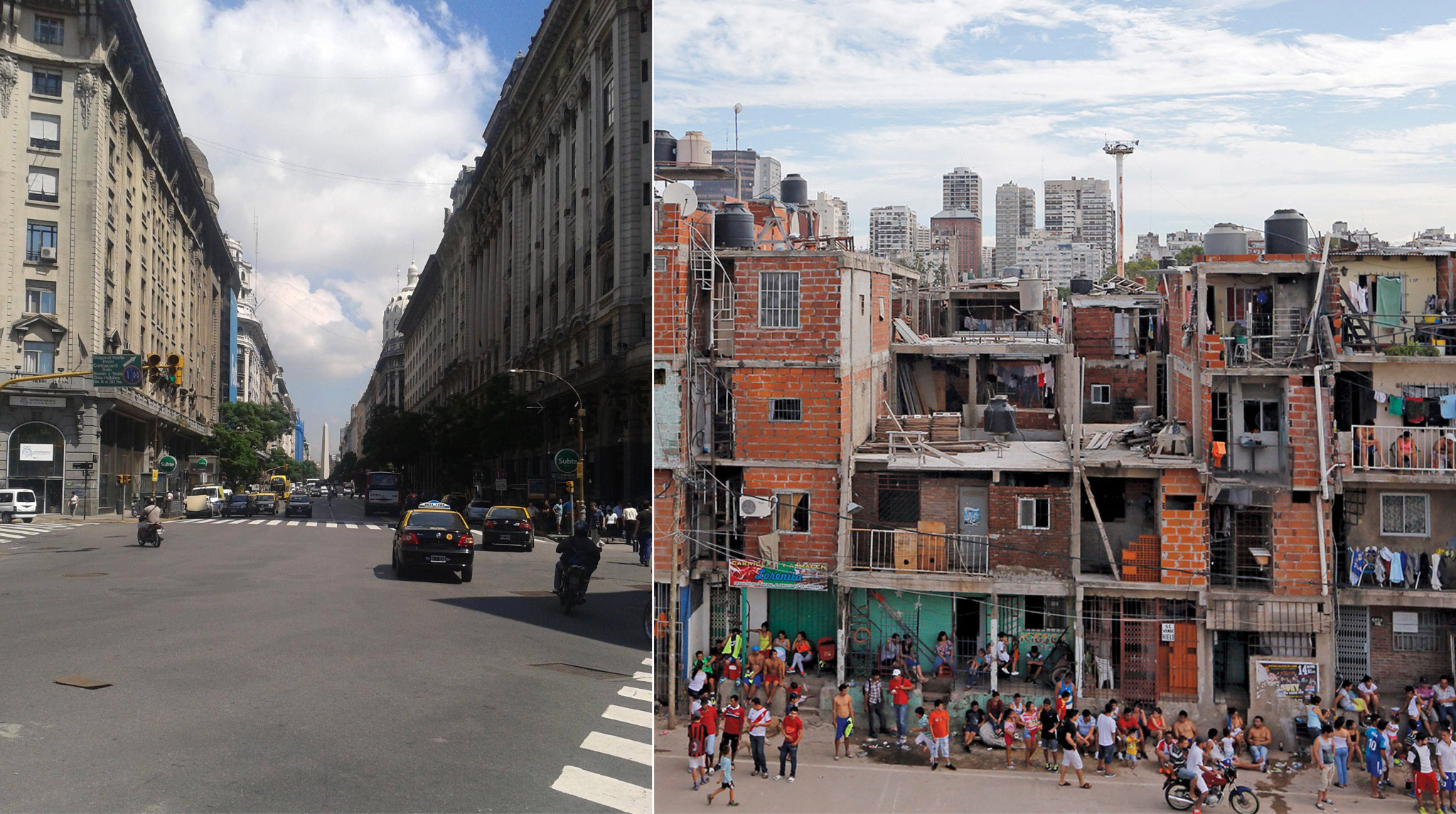
Buenos Aires, 1930s:
Last week, we saw how Argentina’s geography is unbelievably good, yet the country is not that rich. Why?
Try asking this question and see the immediate flood of: Perón took power and destroyed our country!
But the timing doesn’t quite work.
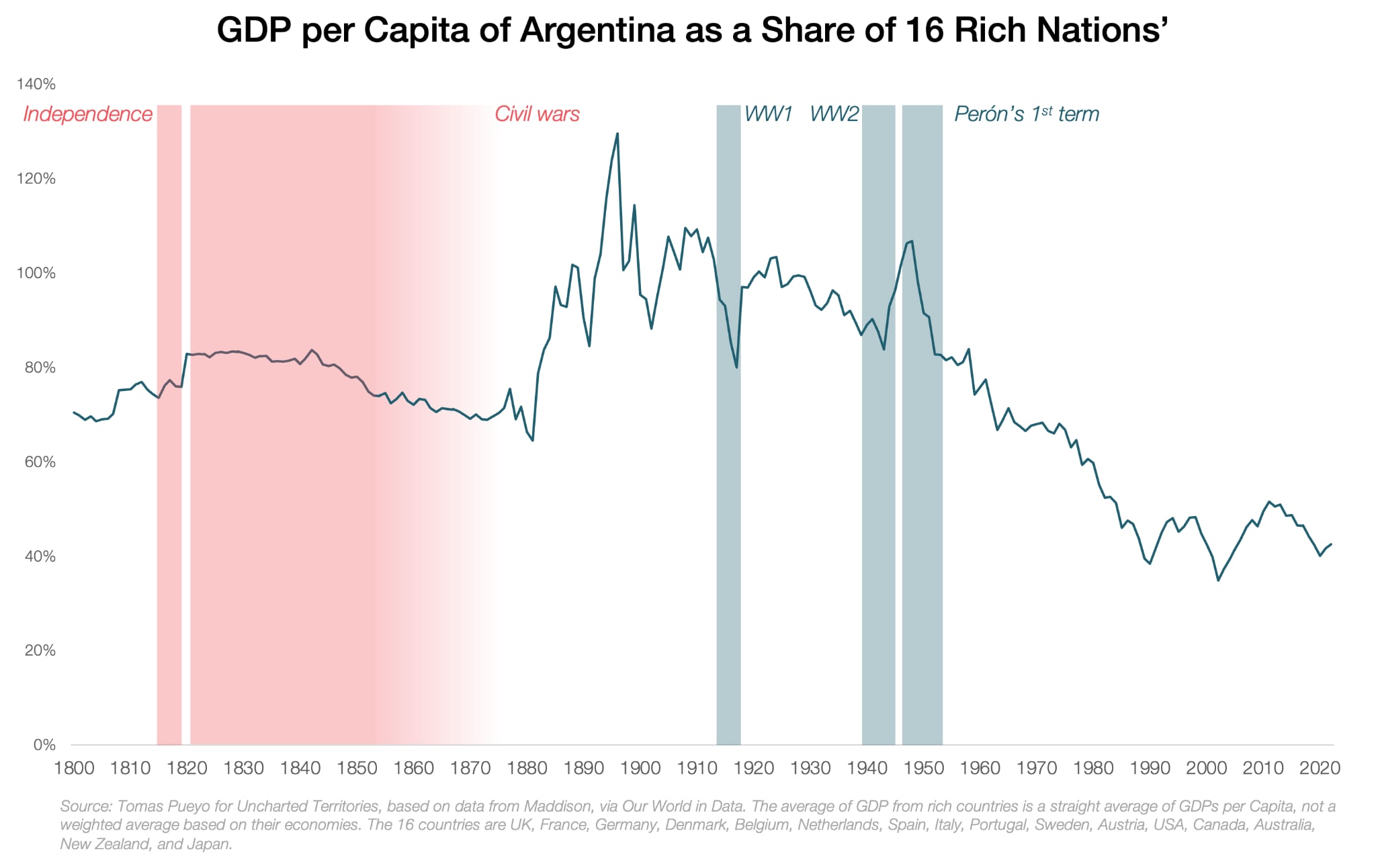
Perón had a role, as we will see later, but the roots must run deeper: Compared to the average wealth of developed countries, Argentina peaked in 1896! The country started a continuous decline around WW1. The beginning of the end for Argentina must have hit around then.
It might help to figure out what made up Argentina’s economy around that time. By the eve of WW1, 35% of Argentina’s GDP came from… agriculture. An additional 22% of GDP came from trade, but 95% of exports were agricultural. In fact, the lion’s share of Argentinian exports is still agriculture.
It’s fair, then, to say that most of Argentina’s economy was agricultural during the country’s apogee, so the original problem in Argentina’s economy must be linked to it: Somehow, Argentina’s agricultural productivity slowed down, and the economy never fully moved on from its dependence on it. Why?
Argentina’s economy went through a massive economic boom starting around 1880.
Compare that with this:
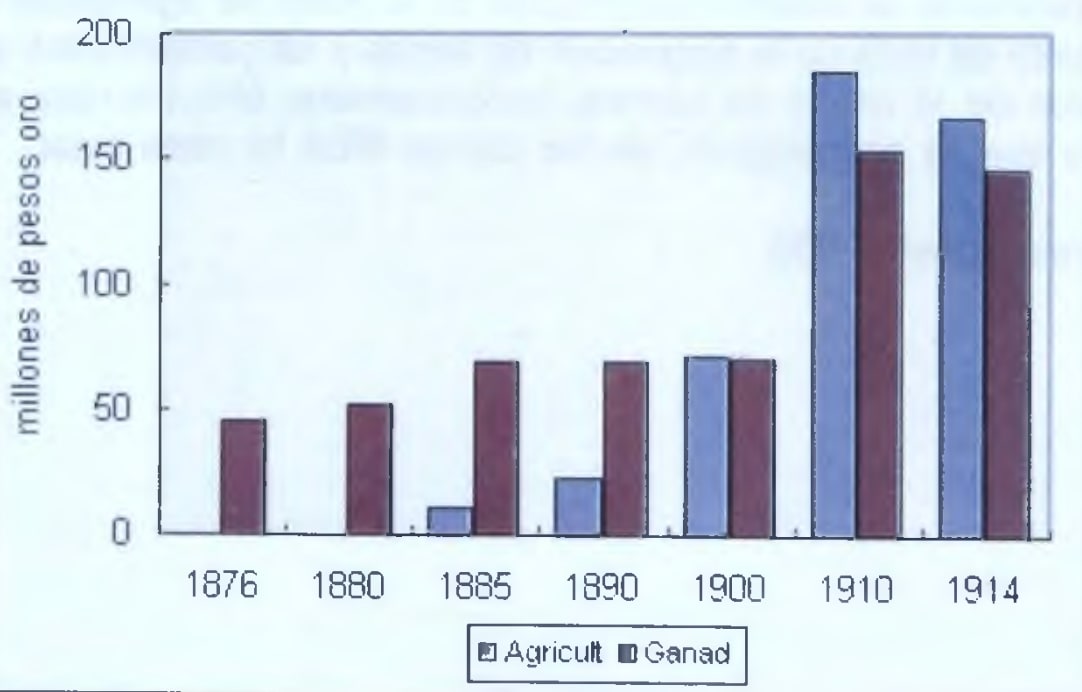
Crop production boomed in the late 1800s: Wheat acreage increased by ~5x between 1890 and 1910.2 93% of the increase in agricultural production until 1930 was due to the addition of new arable land. But that growth decelerated heavily in the early 1900s:
Why? A big factor was land:
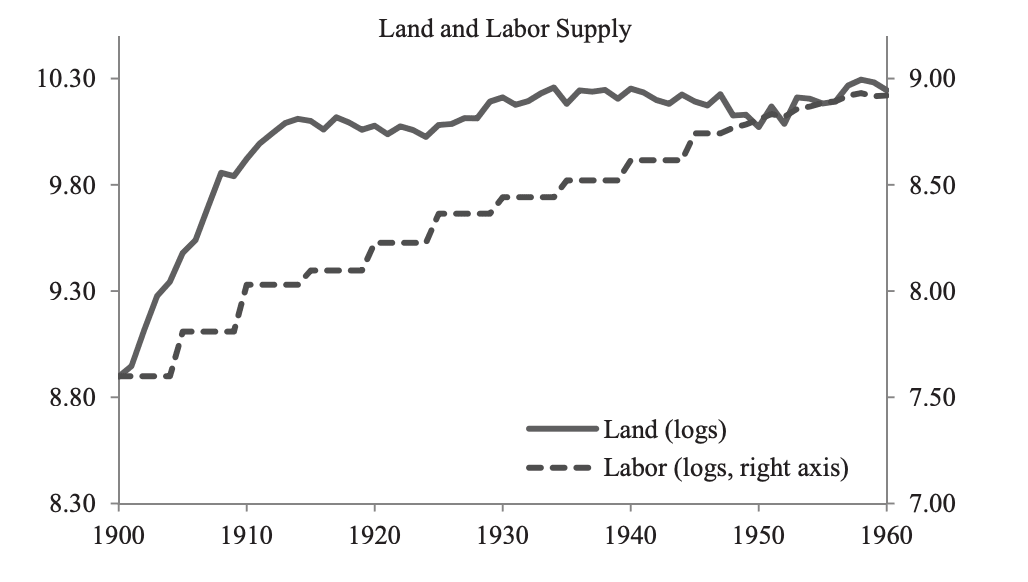
So what happened is that, in the late 1800s and early 1900s, there was a massive agricultural boom in Argentina, and people raced to convert new land from pasture into cropland. This lasted until the 1910s, when all the good land was taken.
This growth in cropland until the 1910s was furthered by other factors:
A wave of European immigrants arrived to work the land and the cattle
Landowners bought agricultural machinery
They also sourced genetically superior cattle
Argentina built its railroads around that time
Refrigeration technology started appearing, after being invented in the 1860s in the US
Steam boats and bigger ships allowed for cheaper transportation of cargo overseas
The combination of these last three reduced the cost of transportation from ~40% in the 1880s to ~10% before WW1.
So more farmers with better machinery produced more crops, while better cattle produced more meat, leather, and wool, all of which could now be transported more cheaply to Buenos Aires, and from there to the world. On the eve of WW1, Argentina’s exports per capita were 2x those of the US! By the 1920s, these developments rendered Argentina’s agricultural yields similar to those in the US.
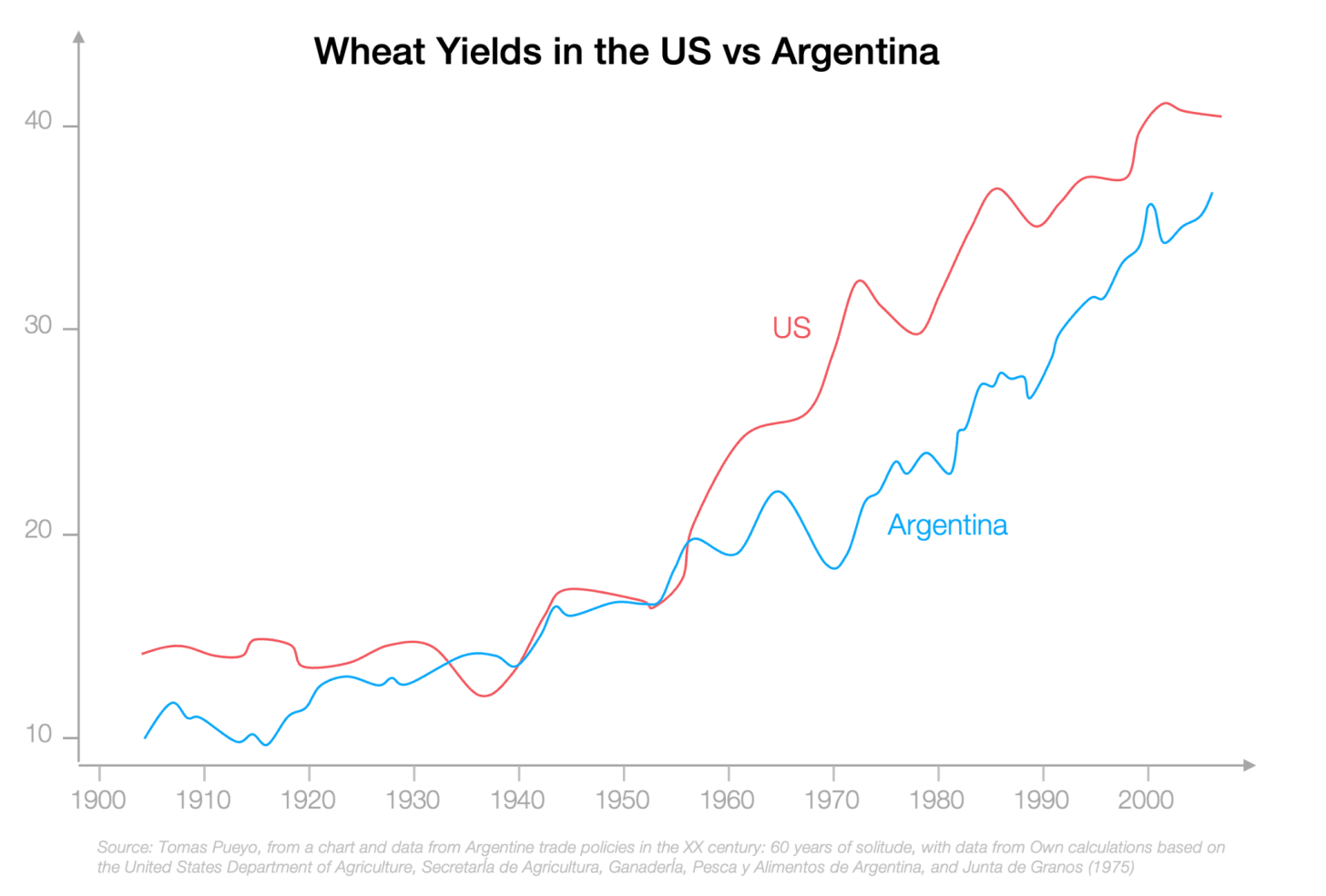
Dig a bit deeper, though, and differences between the US and Argentina become apparent:
Why were Argentinian crop yields lower than the US’s until the early 1900s?
By the time Argentina started planting crops, the US had been doing it for centuries in the East Coast and in the Midwest. Why so late in Argentina?
Argentina had a much longer tradition of ranching than farming. Why?
I mentioned that Argentina started building its railroads in the late 1800s. By then, the US was already criss-crossed with railroads. Why the disparity?
The US’s population had been growing dramatically for over a century by the time Argentina’s started growing. Why?
Argentina’s agricultural land was more concentrated than in the US. Why?
The US was in full Industrial Revolution by the late 1800s, when Argentina was still agrarian. Why?
Answering these questions will get us closer to understanding why Argentina is poorer today than it could have been.
By the early 1914s, the average farm in Argentina was much bigger than in the US or Canada.
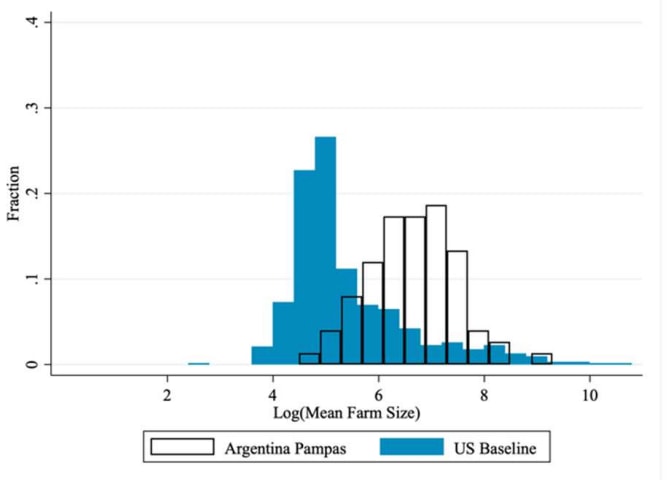
Just 2.5% of landowners held half of Argentina’s farmland! Why? The typical answer to this is:
“Institutions!”
Hold on, not so fast.
US East Coast farms were small, but those in states like Texas, Oklahoma, Kansas, or Missouri were much bigger—just 33% smaller than those in the Argentinian Pampas. Why? The climate in the Pampas is most similar to the climate in these Midwest states.
The rain in the Pampas region is more like that in the ranching part of the US Midwest:
Also, whereas the Mississippi Basin irrigates the US Midwest, the Rio de la Plata Basin doesn’t irrigate the Pampas, which must rely mostly on rain for agriculture.
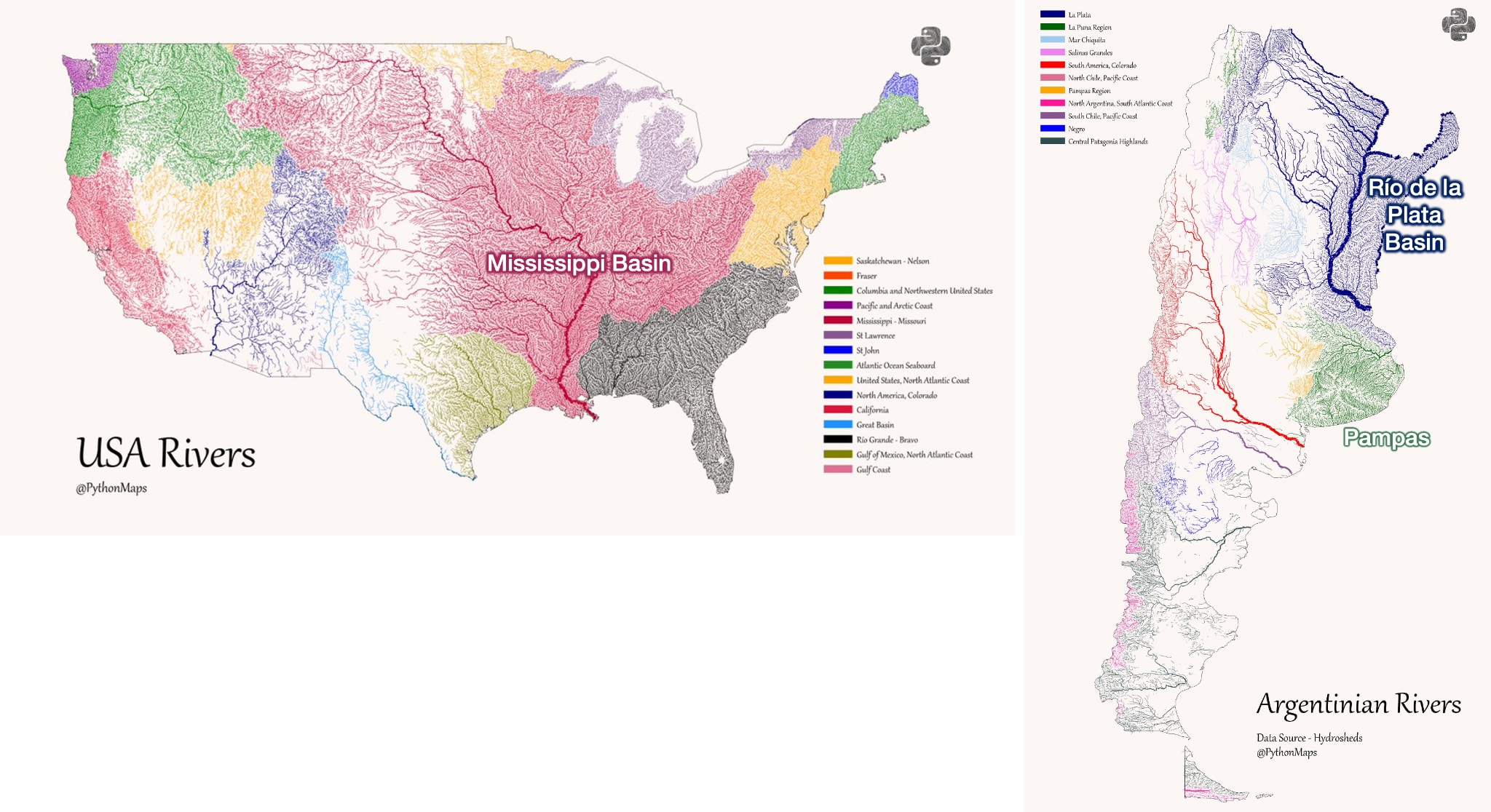
Less rain means less irrigation, and a harder time growing grains, but enough for grasses, which begets ranches.
Of course, this also meant that the Pampas didn’t have the navigable waterways of the Mississippi, which meant grain couldn’t be easily transported by boat to the sea. In fact, there was no easy way to transport grain to the coast because there weren’t even railroads in Argentina until the late 1800s. The only way to transport food production to Buenos Aires (the port to the world) was by making the food walk—that is, to have cattle. But as we mentioned before, cattle could hardly be exported because meat couldn’t be refrigerated until the late 1800s.
Additionally, as we just saw, the big wave of immigration into Argentina started late in the 1800s, so there weren’t many farmers to take care of farms anyway. Ranching requires fewer workers per acre, so it was a much more reasonable solution in a world of near-infinite land and limited people.
Ranches have economies of scale: The bigger the ranch, the more cattle heads, and the fewer cowboys / gauchos needed to take care of them.
So these are most of the reasons why Argentina had lots of ranching and little crop production until the 1800s. We’re just missing one.
We saw that the majority of the farm size gap between the US and Argentina was due to geography, but not all, as Argentinian farms are still bigger than in the US region where they’re biggest. This paper suggests that the other cause of big farms was institutions: Spain and the UK had different ones, and they transposed them into Argentina and the US respectively.3
2025-10-22 09:25:11
I visited Navier last week during the Progress Conference:
This is their boat:
2025-10-16 23:22:47
Encuentra este artículo en español debajo del inglés.
Argentina used to be rich:
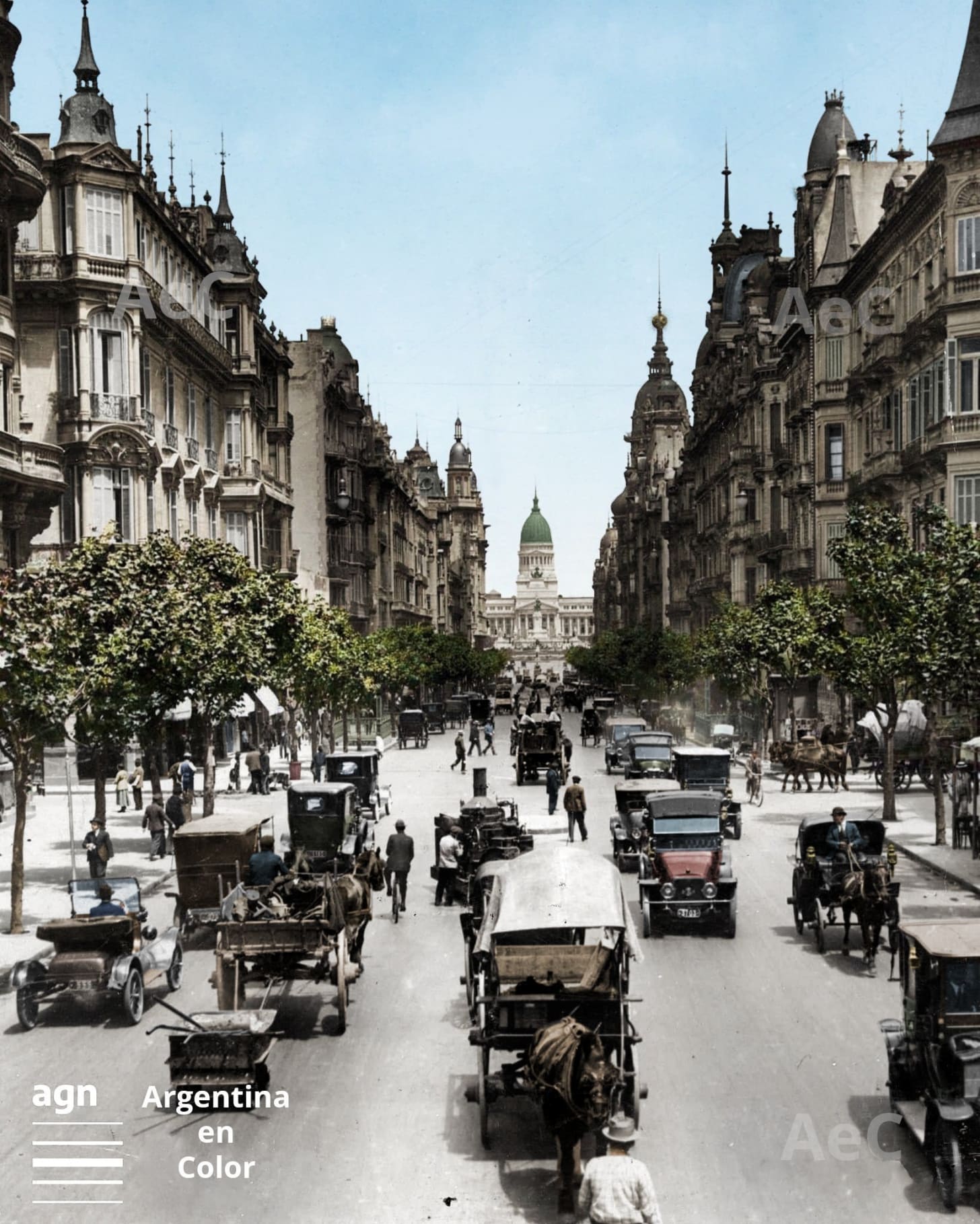
Its capital, Buenos Aires, was “the Paris of South America”.
For decades, Argentina (which means “the country of silver”) was among the richest countries on Earth—richer than France, Germany, Japan, or Italy:
Millions of Europeans flocked there during its Belle Époque, dreaming of being “as rich as an Argentine”.
But then, this happened:
Not only did the Western world leave Argentina behind. Traditionally poorer countries like Chile and China are now richer! And Brazil is catching up!
How is this possible?
Because, unlike most countries I write about, Argentina is poor despite its amazing geography. With better management, it could become the United States of Latin America. Here’s why.
The US is big, but Argentina isn’t too far behind—they’re the world’s 4th and 8th biggest country respectively. Argentina is much bigger than most people realize! It can easily contain France, Spain, Italy, Germany, and over 20 more European countries.1
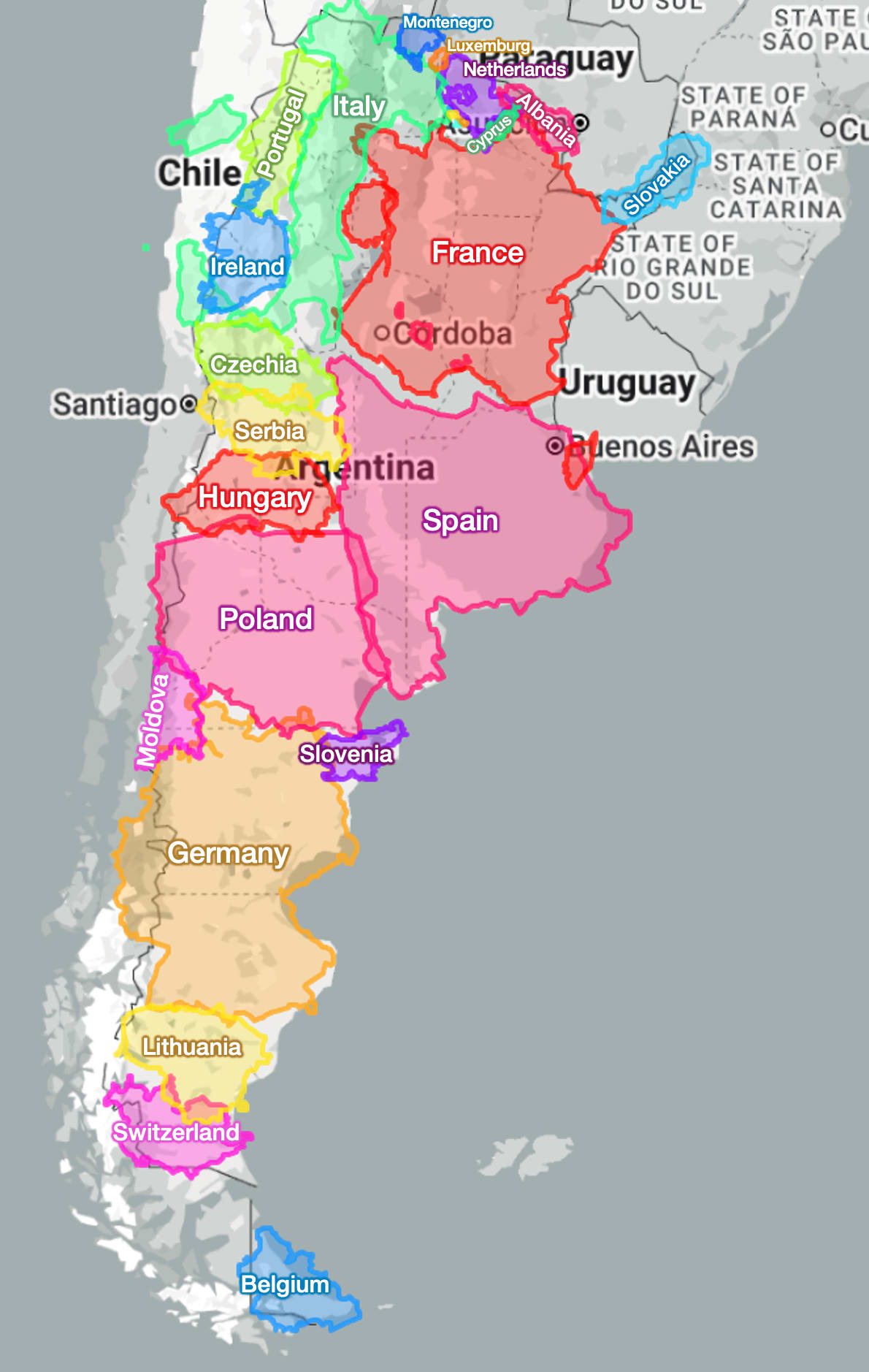
Argentina claims to be quite a bit bigger, though.
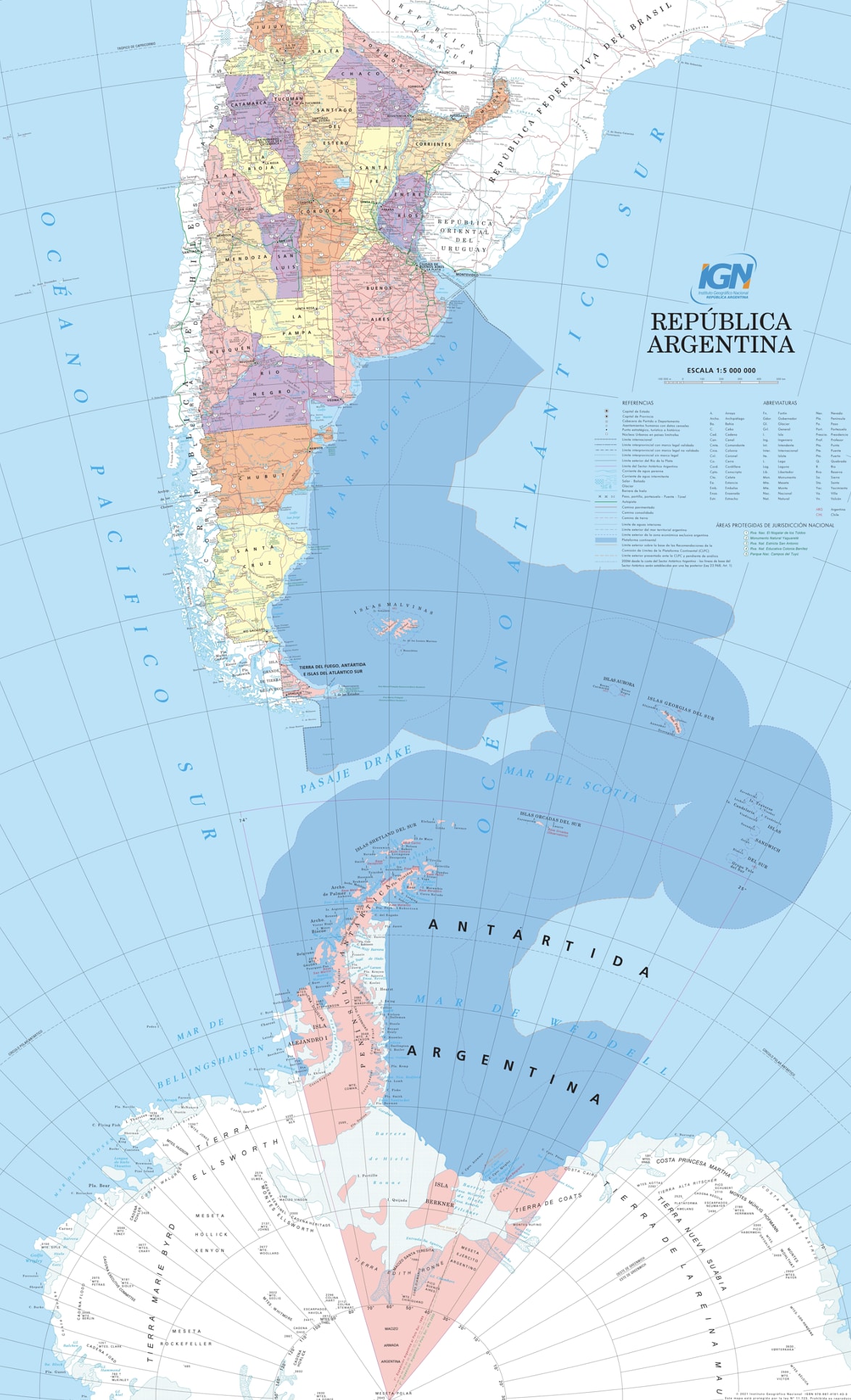
With such a great size comes massive resources and defensibility.
The defensibility of the US and Argentina are surprisingly similar.
One advantage that Argentina has is that it’s even more isolated than the US.
The Pacific is too big for any threat trying to cross it, and Argentina’s western neighbors are even farther than the US’s (Japan is much closer to the US than New Zealand is to Argentina). And of course, Australia and New Zealand are more culturally aligned (and hence less threatening) than the US’s “neighbors”, Russia and China.
The Atlantic Ocean is not as big as the Pacific, but nevertheless much too vast for big powers to threaten Argentina from afar. Again, the US is close to the action (to Europe and Russia), while Argentina’s neighbors on the other side of the Atlantic are much poorer and weaker African countries. As a result, there have been very few naval battles on the coasts of Argentina.
Argentina has no neighbors to its south, and no threat can come from frozen Antarctica. Plus, the Antarctic Ocean is one of the coldest, windiest, most inhospitable oceans in the world. Argentina is safe there.
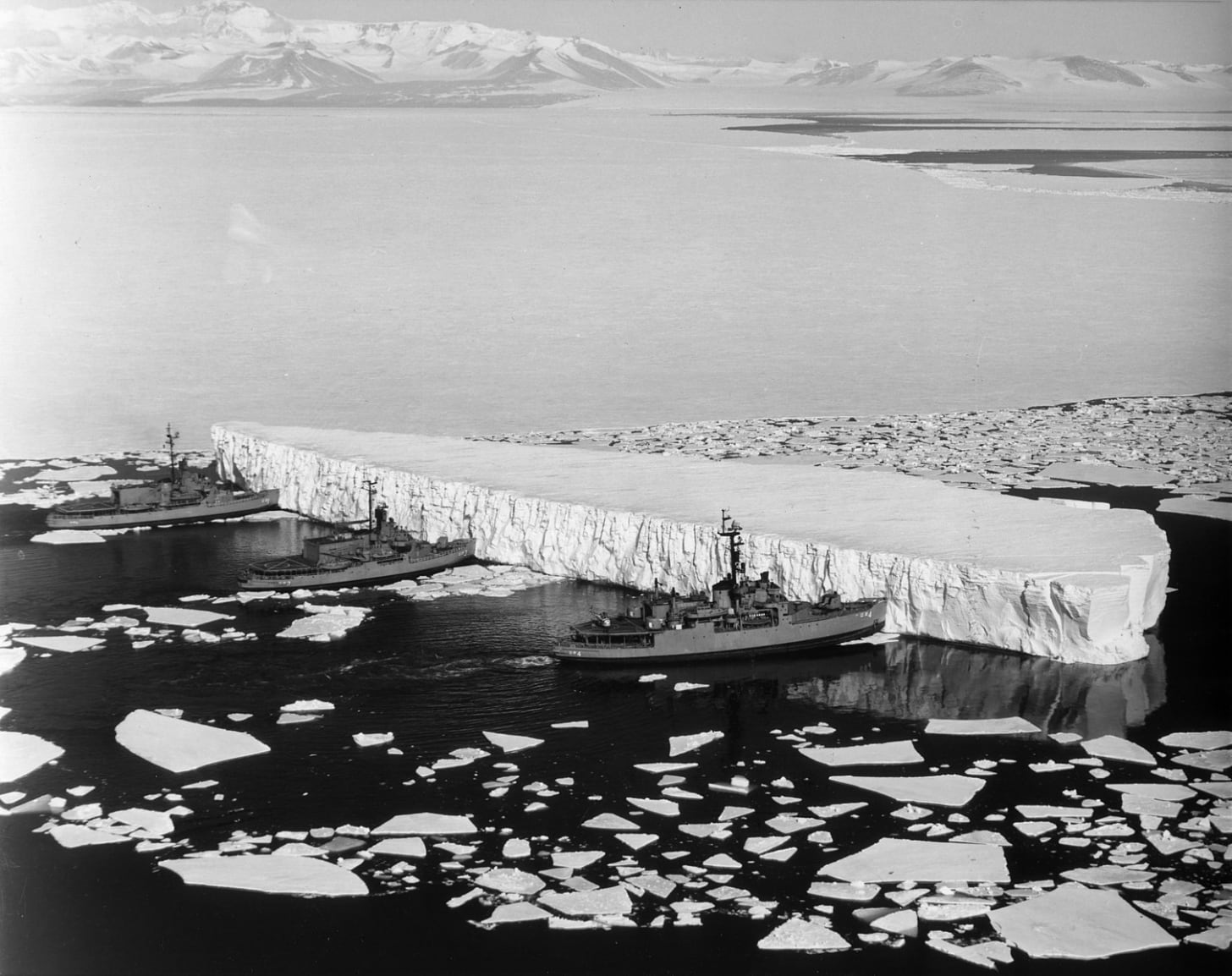
To its west and northwest, one of the tallest mountain barriers on earth protects Argentina from Chile and Bolivia, the Andes:
That mountain range is pretty desertic, too. No army can pass to invade Argentina from there.
To the north, the border with Paraguay is quite flat, but if anyone should be afraid, it’s Paraguay, as Argentina’s economy dwarfs its own.
Paraguay already experienced this in the War of the Triple Alliance against Argentina, Brazil, and Uruguay, in which it lost over half of its population and nearly 40% of its territory.
Argentina only has one threat, but it’s significant.
Can you guess?
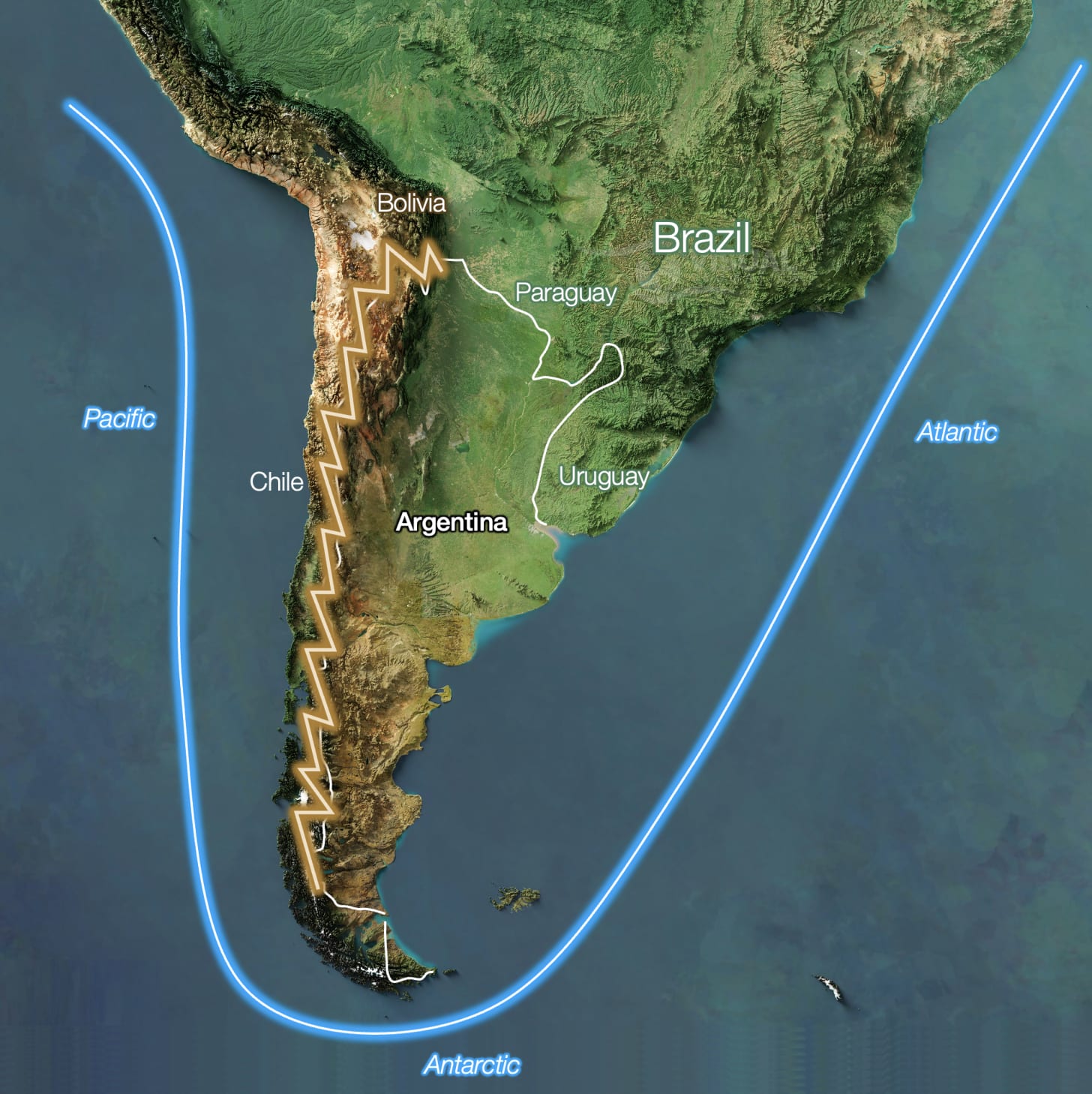
Brazil is much bigger than Argentina, in surface area (3x), population (4.5x), and economy (3.5x).
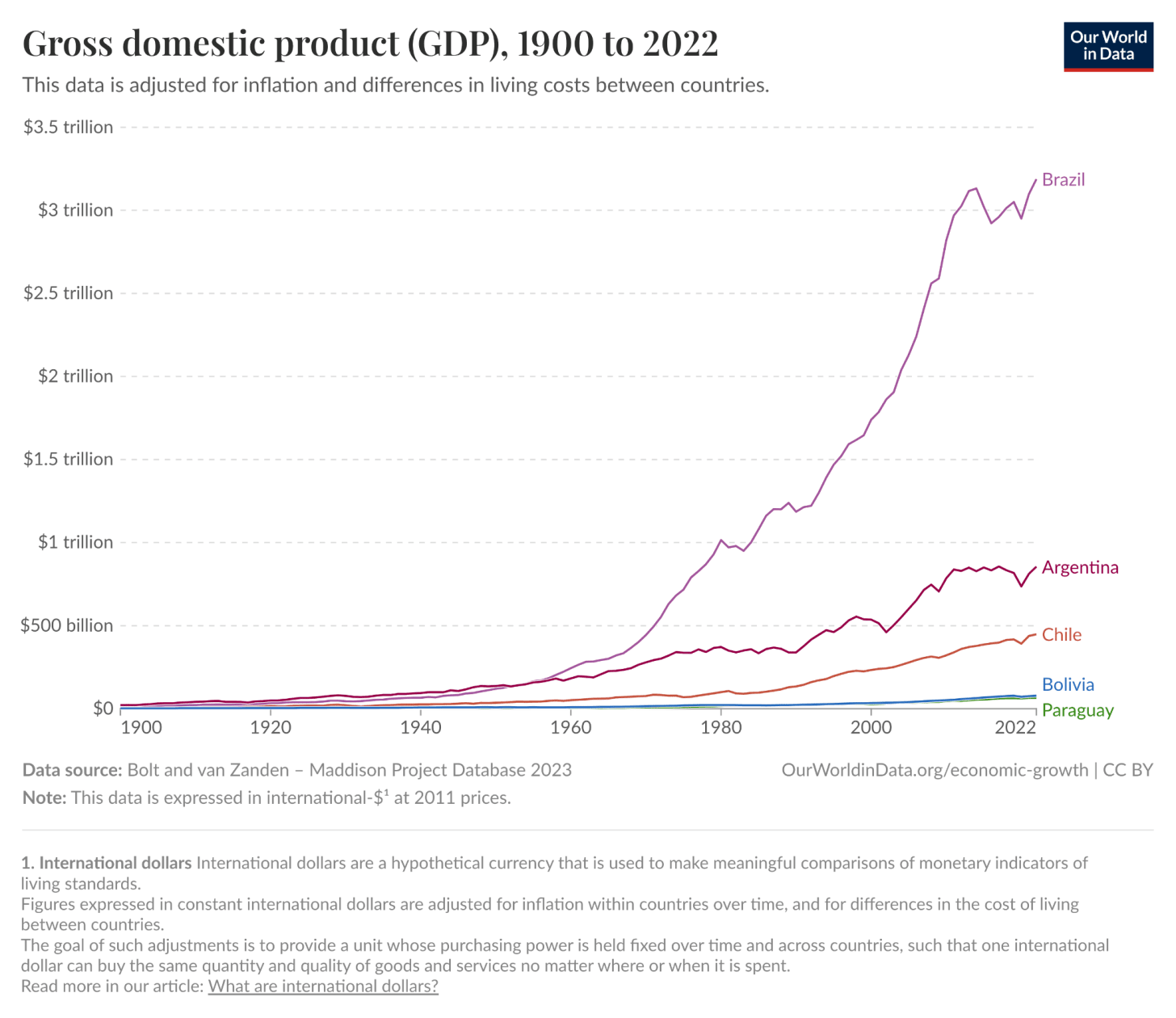
This means Argentina’s first (and nearly only) geostrategic priority is a good relationship with Brazil.
In Never Bet Against America, I highlighted one of the best sources of US power: The Mississippi River Basin.
Since the entire Mississippi river basin is quite flat, it doubles up as an amazing irrigation field for crops and the perfect highway to bring produce to world markets, as it’s the biggest network of natural navigable waterways in the world.
Well, Argentina is the same!
It has a huge flat plain in warm and temperate climates, which is ideal for growing lots of food.
It’s flanked by two mountain ranges that concentrate water into a navigable river basin that reaches the ocean and makes transportation dirt cheap.
And if you think it’s a coincidence, think again, for both lateral mountain ranges have the same origins in the US and Argentina! On the western side, we find the tall mountain ranges.
That’s because they’re young, the product of the ongoing subduction of oceanic plates (the Pacific plate is pushing Cocos and Nazca eastwards) under continental plates (the North and South American ones).
Meanwhile, to the east, the Appalachians, the Canadian Shield, the Brazilian Shield, and Africa used to be part of the same ancient continent!
And in between? Both North and South America had inland seaways in the past!
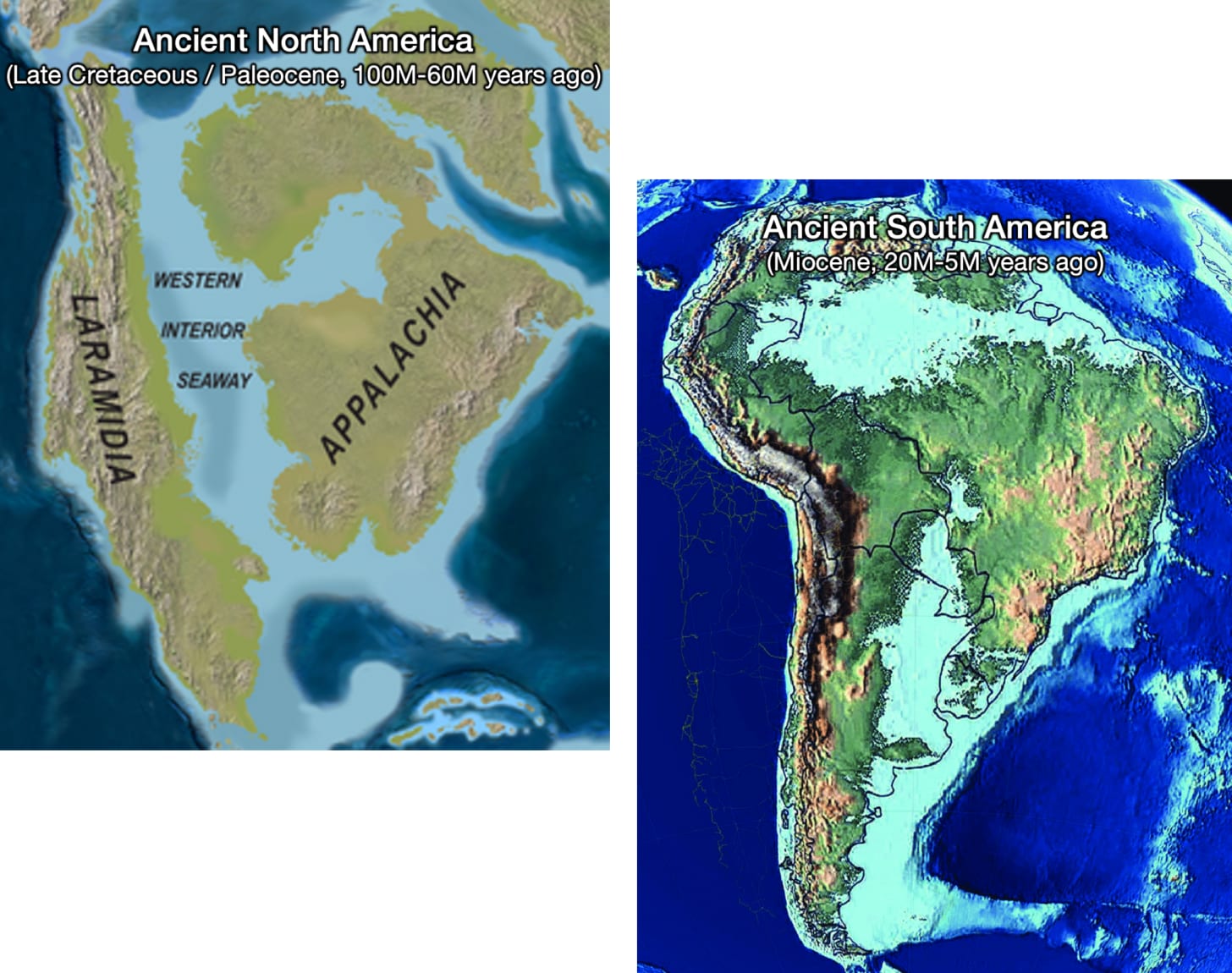
And this is why both areas are low-lying flat plains, with similar soil quality: They formed the same way! A sea formed in between mountain ranges, sediments accumulated, and after the sea receded, rivers and wind slowly deposited more sediments.
Here are the resulting soils in North and South America:
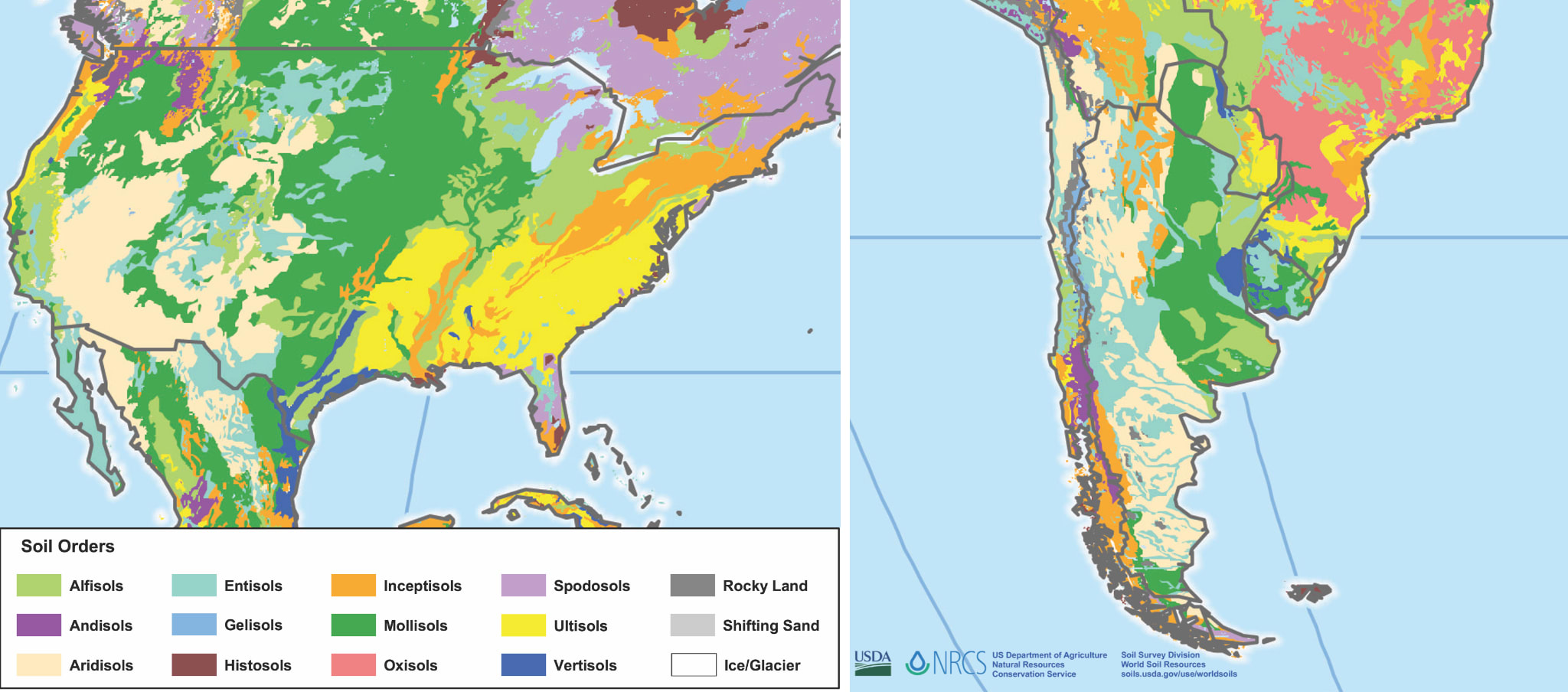
This is the result of these amazing soils:

Of course, for this type of agriculture, you need more than flat terrain full of sediments and great rivers. You need the right climate, including proper temperature and precipitation.
Not only do the US and Argentina have a similar geography for the same geological reasons. They’re also at similar latitudes, just on opposite sides of the equator!
Let’s fold the map around the equator:
This is the key reason why the main climates of these countries are so similar:
Due to the rotation of the Earth, the prevailing winds around the globe look like this:
This makes the US West Coast, the Amazon, and southern Chile very wet. But these rains also affect the north of Argentina, feeding the Río de la Plata basin, and dropping tons of water on the eastern Andes:
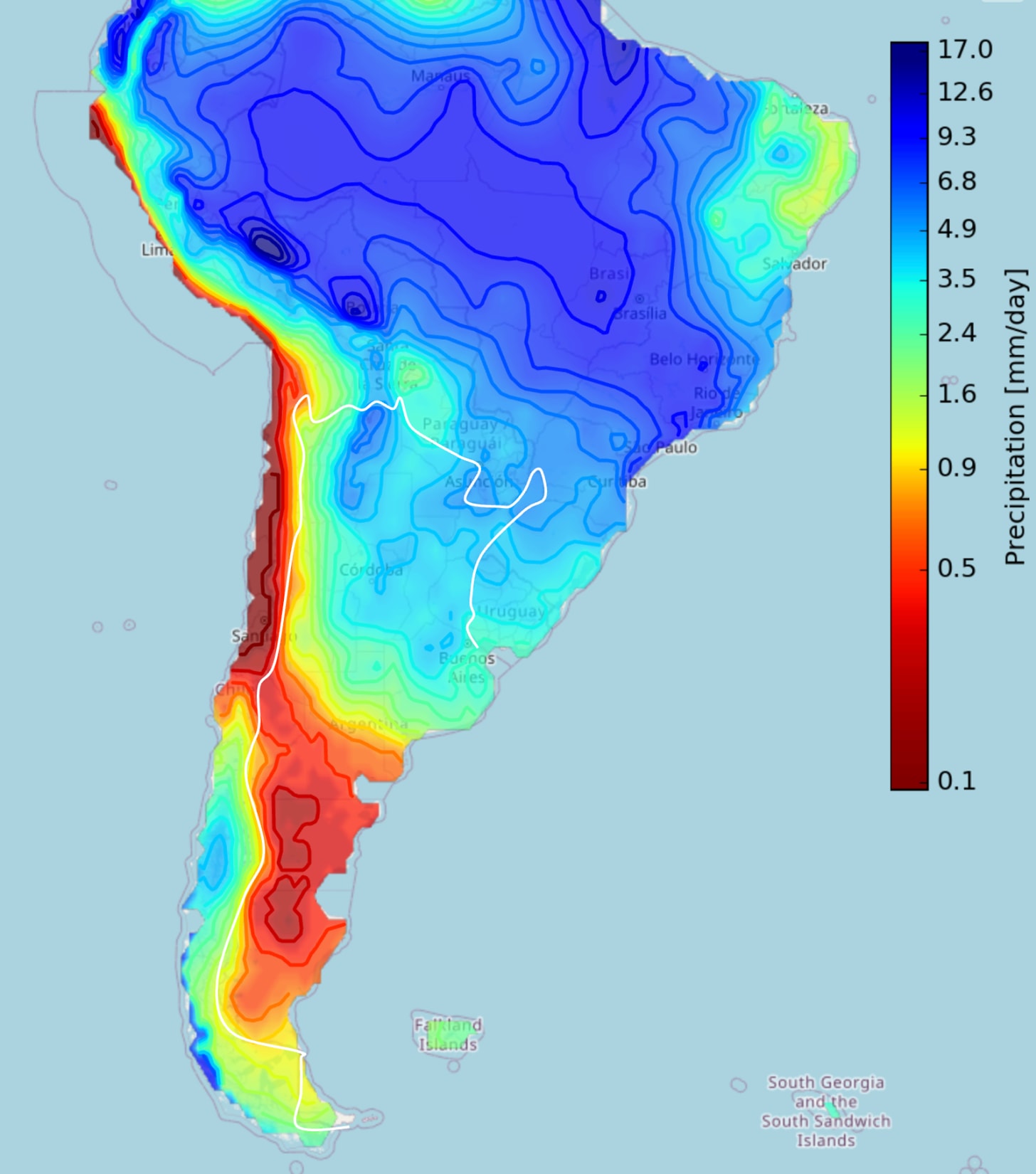
And that’s why northern Argentina gets a lot of rain (and is therefore much greener), while the south is drier and is browner, with more grasses.
The US has a sea to its south that affects the rains,2 so instead of a north-south difference, it has an east-west one. This determines the type of food it produces:
The equivalent for Argentina is agriculture in the north and ranching in the south:
And that’s why you get cowboys in both the US and Argentina—gauchos!
In other words, the US has the Great Plains, Argentina has the Pampas. And with their similar soils and climates, they can produce and export inordinate amounts of food.
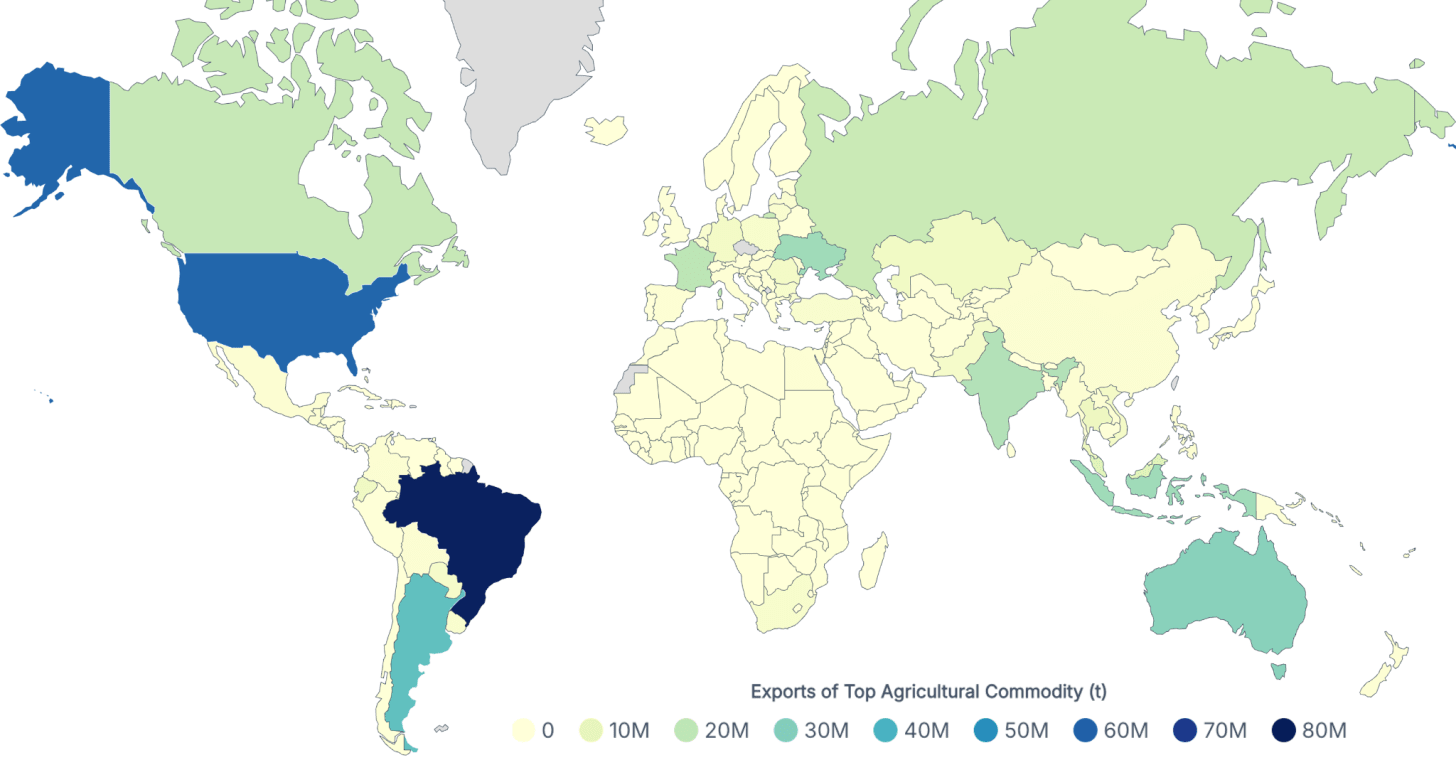
Compare Argentina’s farmland with the rest of South America’s!
Each dollar invested goes much further in Argentina than anywhere else in South America, because it’s much easier and cheaper to build on flat land. You don’t need to level the ground, build retaining walls, fill slopes, displace much soil, build deep, deal with uneven foundations, break hard stone, spend a lot to ship materials and machinery, risk landslides, or pay high insurance premiums to cover for natural risks.
As a reminder, water transportation is 10-30x cheaper than over land, and yet just halving transportation costs can increase trade by up to 16x! That means water transportation can make a region hundreds of times richer. US and Argentinian farmers can make much more money, accumulate more wealth, and invest more easily than those from other countries.
This is why it’s so important that the Río de la Plata system is so navigable:
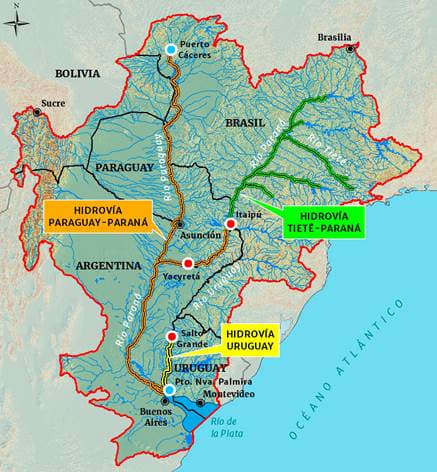
This is crucial in this area, which produces lots of agricultural and mining products that cost little but are heavy—therefore expensive to transport by road. Without this river system, it’s possible that none of these products could be successfully exported.
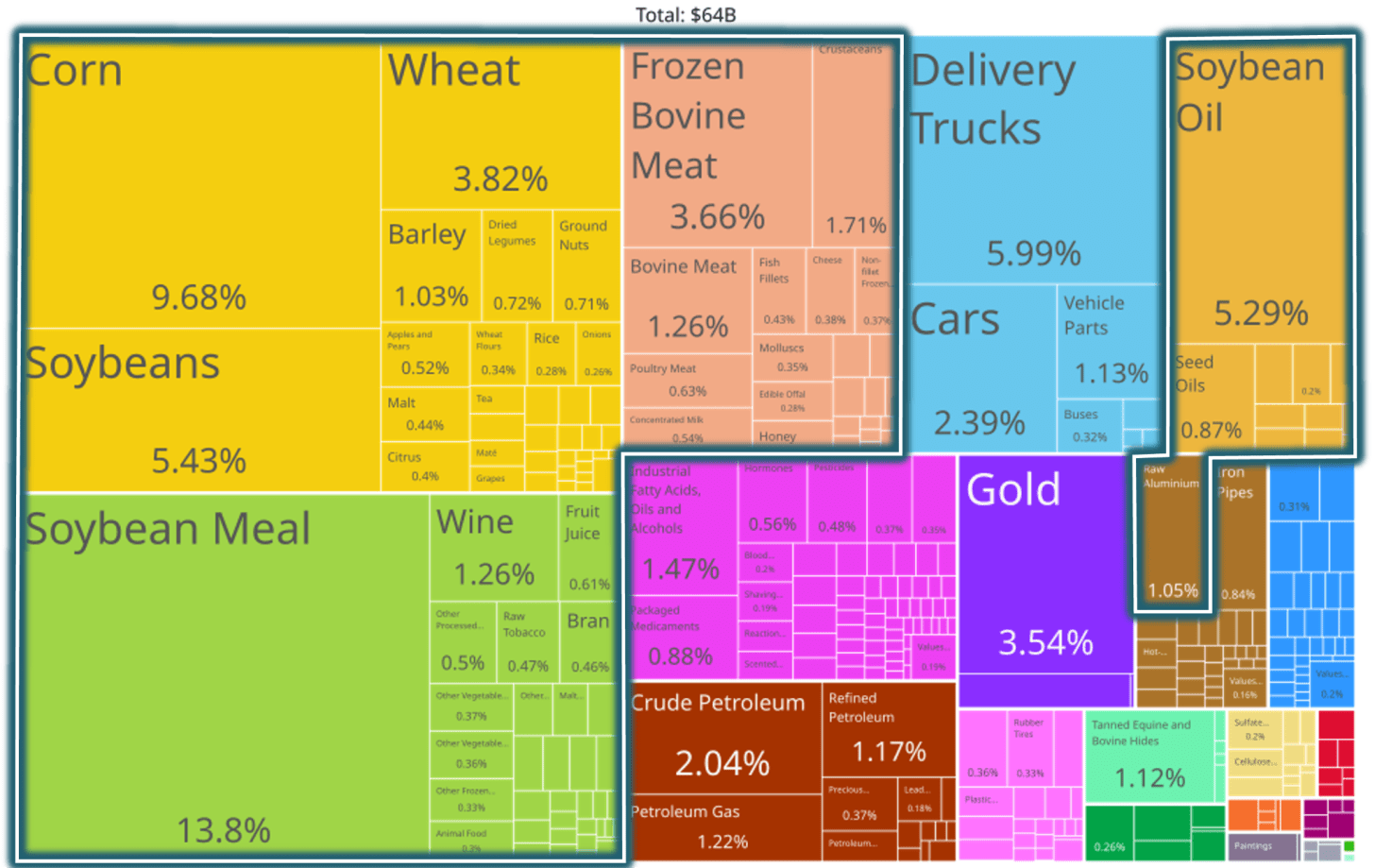
Compare this to Russia, the biggest country in the world with some of the best farmland. It should be the biggest exporter of food in the world. Instead, it sometimes runs out of food because it spoils due to bad weather and transportation!
Argentina, Paraguay, Uruguay, and Brazil fought over their borders after the independence of Latin America in the first half of the 1800s. But after the War of the Triple Alliance, they were done. The countries haven’t gone to war with each other in over 150 years, and a key reason for this is the Río de la Plata system.
As we discussed in Never Bet Against America, the Mississippi is a cultural and political unit because local populations constantly trade with each other and their trading interests are the same. This was not the case on the East Coast of the US (as rivers flow from the mountains to the coasts), and isn’t the case in Europe either, which is why so many nations emerged there and they fought so many wars.
The Río de la Plata is the same, a single river system that promotes trade, cultural exchange, communication, and cooperation. It’s the second biggest interconnected navigable river waterway in the world after the Mississippi, and Argentina holds the key to the system: Buenos Aires.
Look at the Río de la Plata:
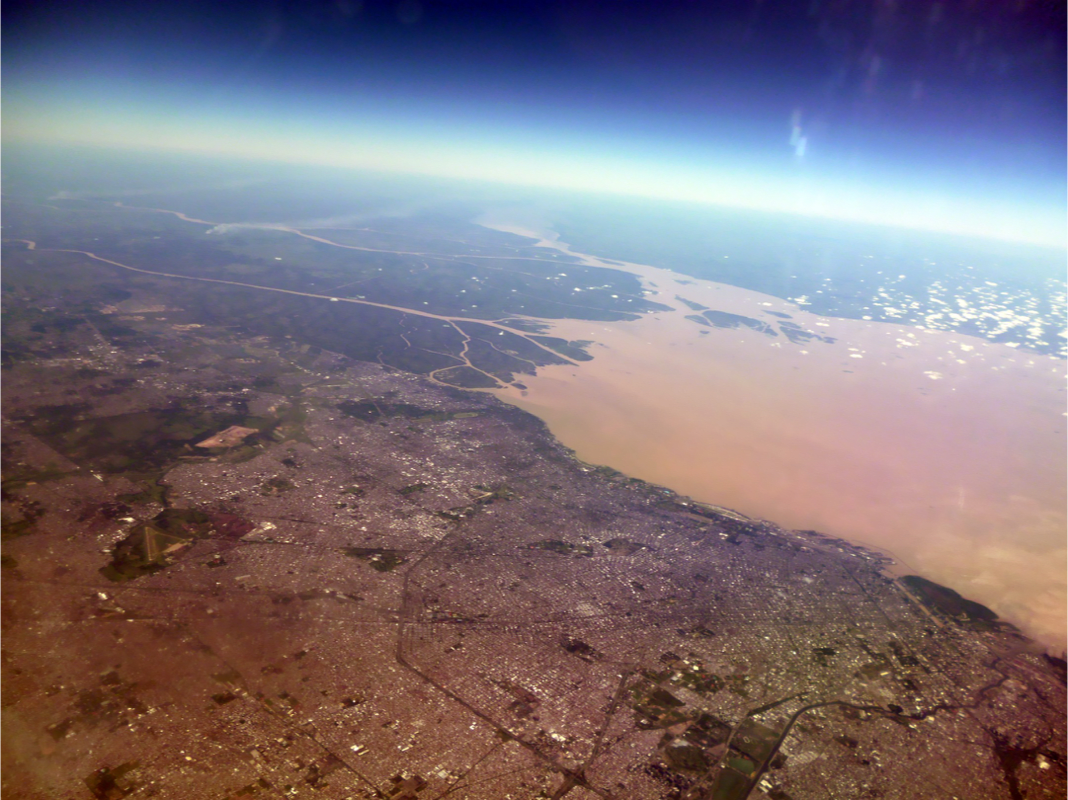
It is not a coincidence that Buenos Aires, Argentina’s capital, is found right where the Paraná and Uruguay rivers meet to form the Río de la Plata: It’s the perfect hub to trade all the products from the north of Argentina, Paraguay, southern Brazil, and Uruguay.
This gives Buenos Aires an incredible economic clout and lots of leverage on all its northern neighbors, who must go through Argentinian waters and the Buenos Aires port to trade with the world.
Chile is one of the biggest exporters of minerals (copper, lithium, silver, iron), but Argentina is not. Yet they’re both on the same mountain range!
Chile has been a bit luckier here, because the rains on their side have created more erosion and exposed more ores, which are easy to transport to the nearby coast. Argentina needs more prospecting and infrastructure to bring trains, roads, and water to its mining regions. This is possible but it requires more investment.
With all these assets, Argentina could be a world superpower. But it’s not. What happened? We saw that Argentina’s GDP per capita is much lower than the US’s despite having a similar geography. But it’s not the only difference. Here is Argentina’s population density:
You can notice a few things:
See that huge spike? Buenos Aires concentrates a huge share of Argentina’s population: 38%!
The dark circle represents the Pampas, with the good climate we saw. But it has very few big cities. Look how it compares to the US’s Midwest.
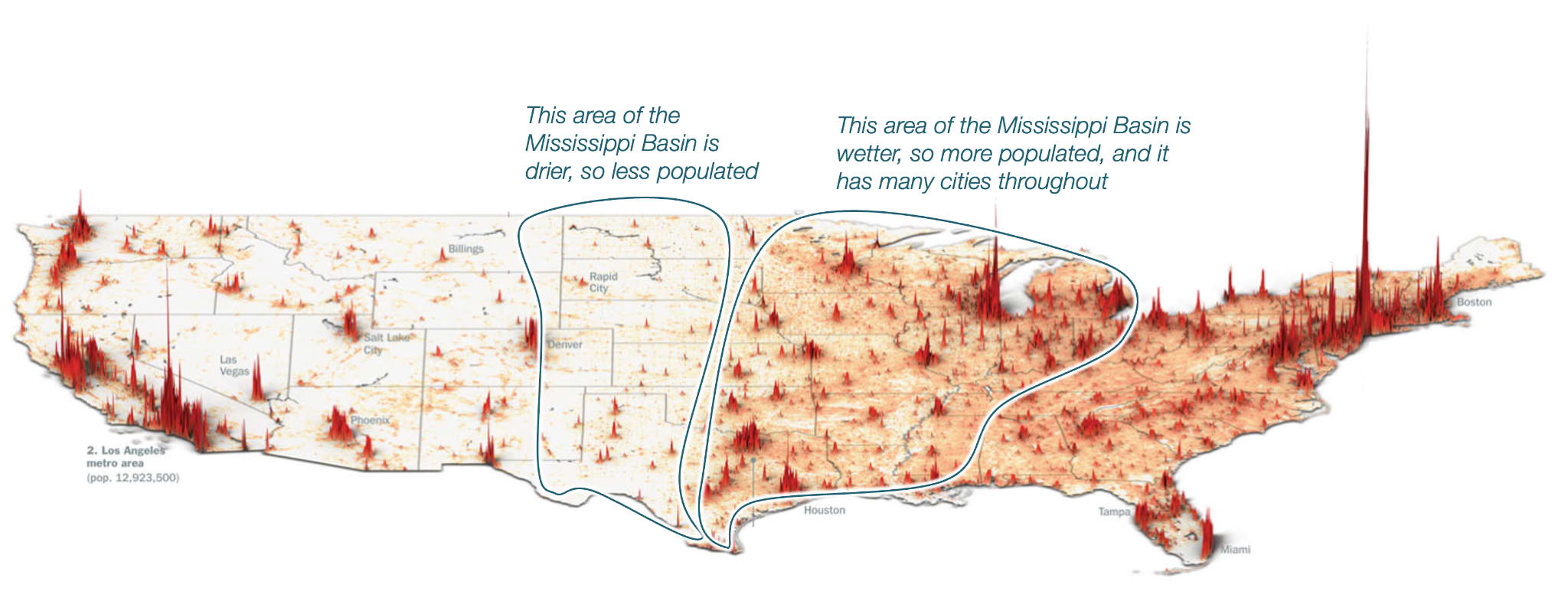
Outside of the Pampas, you can see population along the fall line of the Andes mountains
This is very typical of cities: People live on flatlands because it’s easier and cheaper, but stay close to mountains to benefit from their resources.
Outside of Buenos Aires and the Andes’ foothills, there is very little population, even in areas that have a similar climate in the Northern Hemisphere and are more populated there!
The US is not very densely populated: Germany hosts 240 people per km2, while the US only has 37 (6.5x less). Argentina is less populated still, at 16.8 people per km2, or 55% less than the US and 93% less than Germany! If it had the same population density as the US, it would be a sizable 94M strong. If it had Germany’s, it would have 680M!
Why so unpopulated despite ideal land?
Over the last 250 years, while immigrants were pouring into the US, Argentina was only growing as fast as Canada, which has a much worse climate.
What can we make of all of this?
Argentina is basically the US of the Southern Hemisphere:
Very similar defensibility, with oceans, mountains, and ice on three sides, and weak neighbors on the other
The huge exception is Argentina’s neighbor, Brazil.
Very similar land and climate, allowing for a world-class agriculture industry and cheap infrastructure.
A very similar navigable river basin in the heartland, helping reduce transportation costs, and creating wealth and political harmony, all controlled from Buenos Aires.
Huge, untapped mineral deposits.
Despite these striking advantages, Argentina has not been able to translate them into immigration and wealth. Geography is not destiny.
One way to put it: Geography is the hardware, our institutions are the software. When both work well, a country is unstoppable. With bad hardware but intelligent software, a country can go far. But it’s easy to waste good hardware with very bad software. This is what Argentina has done. Another way to put it: Geography is the chessboard: How you play on it determines your success, and Argentina hasn’t played very well. Why? This is what we will explore in the next article. Subscribe to read it!
Versión en español:
Argentina era rica:

Su capital, Buenos Aires, era “el París de Suramérica”.
Durante décadas, Argentina (“país de la plata”) fue uno de los países más ricos del mundo—más que Francia, Alemania, Japón o Italia.
Millones de europeos emigraron allí durante su Belle Époque, soñando con “ser tan ricos como un argentino”.
Pero ocurrió esto:
Argentina se ha quedado atrás en comparación con el resto del mundo occidental. Países tradicionalmente más pobres, como Chile o China, son hoy más ricos. ¡Y Brasil la está alcanzando!
¿Cómo es posible?
Porque, a diferencia de la mayoría de países de los que suelo escribir, Argentina es pobre a pesar de su geografía extraordinaria. Con una mejor gestión, podría convertirse en los Estados Unidos de América del Sur.
He aquí el porqué.
Estados Unidos es grande, pero Argentina no se queda tan atrás: son, respectivamente, el cuarto y el octavo país más extensos del mundo. Argentina es mucho más grande de lo que la mayoría se imagina. Podría contener sin problema a Francia, España, Italia, Alemania y más de veinte países europeos adicionales.

Argentina afirma ser aún más grande.

Este tamaño gigantesco le otorga recursos inmensos e impregnabilidad.
La capacidad de defensa de Estados Unidos y Argentina es sorprendentemente similar.
Una ventaja argentina es que se encuentra aún más aislada del resto del mundo.
El Pacífico es demasiado vasto para que vecinos del otro lado puedan amenazar a Argentina. Además, esos vecinos están incluso más lejos que los de EE. UU. (Japón está mucho más cerca de Estados Unidos que Nueva Zelanda de Argentina).
Y Australia y Nueva Zelanda están más alineadas culturalmente —y, por tanto, son menos amenazantes— que los “vecinos” de Estados Unidos, Rusia y China.
El Atlántico no es tan inmenso como el Pacífico, pero sigue siendo demasiado ancho para que potencias lejanas puedan proyectar fuerza hacia Argentina.
De nuevo, Estados Unidos está más cerca de los focos de tensión (Europa y Rusia), mientras que los países al otro lado del Atlántico de Argentina son naciones africanas más pobres y débiles. Resultado: muy pocas batallas navales se han librado en las costas argentinas.
Argentina no tiene vecinos al sur, y ninguna amenaza puede llegar desde la helada Antártida. Además, el océano Antártico es uno de los más fríos, ventosos e inhóspitos del planeta. Por allí, Argentina está completamente segura.

Al oeste y noroeste, una de las barreras montañosas más altas del mundo protege a Argentina de Chile y Bolivia: los Andes.
Esa cordillera, además, es bastante desértica. Ningún ejército puede atravesarla para invadir el país.
Al norte, la frontera con Paraguay es bastante llana, pero si alguien debe tener miedo, es Paraguay: la economía argentina supera con creces a la suya.
Paraguay ya lo experimentó durante la Guerra de la Triple Alianza contra Argentina, Brasil y Uruguay, en la cual perdió más de la mitad de su población y cerca del 40% de su territorio.
Argentina solo tiene una amenaza, pero es significativa.
¿Puedes adivinar cuál?

Brasil es mucho más grande que Argentina: tres veces en superficie, 4,5 veces en población y 3,5 veces en economía.

Esto significa que la primera —y casi única— prioridad geoestratégica de Argentina es mantener una buena relación con Brasil.
En Never Bet Against America, señalé una de las mayores fuentes del poder estadounidense: la cuenca del río Misisipi.
Como toda esa cuenca es bastante llana, sirve tanto como un excelente sistema de riego agrícola como una autopista natural para transportar productos a los mercados mundiales, ya que es la red de vías navegables naturales más grande del planeta.
Argentina es igual!
Tiene una vasta llanura cálida y templada, ideal para producir alimentos en cantidad.
Está flanqueada por dos cordilleras que concentran el agua en una cuenca fluvial navegable que desemboca en el océano, haciendo que el transporte sea baratísimo.
¿Casualidad? Qué va. Ambas cadenas montañosas laterales tienen los mismos orígenes en Estados Unidos y Argentina. En el lado occidental se encuentran las cordilleras altas:
Estas montañas son tan altas porque son jóvenes, producto de la subducción actual de las placas oceánicas (la placa del Pacífico empuja las de Cocos y Nazca hacia el este) bajo las placas continentales (la norteamericana y la suramericana).
Mientras tanto, al este, los Apalaches, el Escudo Canadiense, el Escudo Brasileño y África formaban parte del mismo antiguo continente.
?Y entre ambas cordilleras? ¡Tanto Norteamérica como Suramérica tuvieron mares interiores en el pasado!

Y esta es la razón por la que ambas zonas son llanuras bajas y planas, con suelos de calidad similar: se formaron del mismo modo! Un mar se formó entre las montañas, se acumularon sedimentos, y cuando el mar retrocedió, los ríos y el viento siguieron depositando más.
Éste es el resultado en la tierra de América del Norte y del Sur:

Éste es el resultado de esos suelos excepcionales:

Por supuesto, para este tipo de agricultura no basta con un terreno llano lleno de sedimentos y grandes ríos. Hace falta también el clima adecuado: temperatura y precipitaciones en el punto justo.
Estados Unidos y Argentina no sólo tienen geografías parecidas por razones geológicas. También están en latitudes similares, solo que a lados opuestos del ecuador!
Doblemos el mapa alrededor del ecuador:
Esta es la clave de por qué los climas principales de ambos países son tan parecidos:
Debido a la rotación de la Tierra, los vientos dominantes del planeta son así:
Esto hace que la costa oeste de Estados Unidos, la Amazonia y el sur de Chile sean muy húmedos. Pero esas lluvias también afectan al norte de Argentina, alimentando la cuenca del Río de la Plata y dejando enormes cantidades de agua sobre los Andes orientales.

Y por eso el norte de Argentina recibe mucha lluvia (y es, por tanto, más verde), mientras el sur es más seco y más pardo, con más pastos.
Estados Unidos tiene un mar al sur que influye en las lluvias, lo que cambia la predominancia pluvial norte-sur por este-oeste. Esto determina el tipo de alimentos que produce.
El equivalente argentino es la agricultura en el norte y la ganadería en el sur.
Y por eso hay cowboys en Estados Unidos y gauchos en Argentina!
En otras palabras: Estados Unidos tiene las Grandes Llanuras, Argentina tiene las Pampas. Y con tierras y climas tan parecidos, ambos pueden producir y exportar cantidades desmesuradas de alimentos.

Compara la superficie agrícola de Argentina con la del resto de Suramérica:
Cada dólar invertido rinde mucho más en Argentina que en cualquier otro lugar de Suramérica, porque es mucho más fácil y barato construir en terreno plano: no es necesario nivelar el suelo, levantar muros de contención, rellenar pendientes, mover grandes volúmenes de tierra, excavar profundamente, lidiar con cimientos irregulares, romper piedra dura, gastar demasiado en transporte de materiales y maquinaria, asumir riesgos de deslizamientos, ni pagar primas de seguro elevadas para cubrir riesgos naturales.
Recuerda que el transporte por agua es entre 10 y 30 veces más barato que el terrestre, y que reducir a la mitad los costos de transporte puede multiplicar el comercio hasta 16 veces! Si combinas estos efectos te das cuenta de que un buen transporte fluvial puede hacer que una región sea cientos de veces más rica. Los agricultores estadounidenses y argentinos pueden ganar mucho más dinero, acumular más capital e invertir con mayor facilidad que los de otros países.
Por eso es tan importante que el sistema del Río de la Plata sea tan navegable:

Esto es crucial en esta región, que produce muchos bienes agrícolas y mineros de bajo valor unitario pero muy pesados, por lo tanto caros de transportar por carretera.
Sin este sistema fluvial, es posible que ninguno de estos productos pudiera exportarse de forma rentable!

Compara con Rusia, el país más grande del mundo y con algunas de las mejores tierras agrícolas. Debería ser el mayor exportador de alimentos del planeta. En cambio, a veces se queda sin ellos, porque se echan a perder por las malas comunicaciones del país
Argentina, Paraguay, Uruguay y Brasil disputaron sus fronteras tras las independencias latinoamericanas en la primera mitad del siglo XIX. Pero después de la Guerra de la Triple Alianza, no se han vuelto a enfrentar en más de 150 años, y una razón clave de esa paz es el sistema del Río de la Plata.
Como vimos en Never Bet Against America, el Misisipi constituye una unidad cultural y política porque las poblaciones locales comercian constantemente entre sí y comparten los mismos intereses económicos. No ocurría lo mismo en la costa este de Estados Unidos (donde los ríos fluyen de las montañas al mar), ni ocurre en Europa, motivo por el cual allí surgieron tantas naciones y tantas guerras.
El Río de la Plata cumple el mismo papel: es un único sistema fluvial que favorece el comercio, el intercambio cultural, la comunicación y la cooperación. Es la segunda red navegable interconectada más grande del mundo después del Misisipi, y Argentina posee la clave del sistema: Buenos Aires.
Mira el Río de la Plata:

No es casualidad que la capital argentina esté justo donde el Paraná y el Uruguay se unen para formar el Río de la Plata: es el centro perfecto para comerciar todos los productos del norte de Argentina, Paraguay, el sur de Brasil y Uruguay.
Esto le otorga a Buenos Aires un peso económico enorme y una gran capacidad de influencia sobre todos sus vecinos del norte, que deben pasar por aguas argentinas y por su puerto para comerciar con el mundo.
Chile es uno de los mayores exportadores del mundo de minerales (cobre, litio, plata, hierro), pero Argentina no. Y, sin embargo, ambos países comparten la misma cordillera!
Chile ha tenido algo más de suerte en este aspecto, porque las lluvias de su lado han generado más erosión y expuesto más vetas minerales, que además están cerca de la costa y son fáciles de transportar. Argentina, en cambio, necesita más prospección e infraestructura para llevar trenes, carreteras y agua a sus regiones mineras.
Es factible, pero requiere más inversión.
Con todos estos recursos, Argentina podría ser una superpotencia mundial.
Pero no lo es. ¿Qué pasó?
Vimos que el PIB per cápita de Argentina es mucho más bajo que el de Estados Unidos, pese a tener una geografía similar. Pero no es la única diferencia. Observa la densidad de población argentina:
Hay varias cosas que saltan a la vista.
Ese enorme pico representa Buenos Aires, que concentra una parte desproporcionada de la población: 38%!
El círculo oscuro marca las Pampas, con el buen clima que vimos antes.
Pero allí hay muy pocas ciudades grandes. Compáralo con el Midwest estadounidense.

Fuera de las Pampas, se nota población a lo largo de la línea de contacto con los Andes.
Esto es muy típico: la gente vive en las llanuras —porque es más fácil y barato—, pero cerca de las montañas, para aprovechar sus recursos.
Fuera de Buenos Aires y del pie de los Andes, hay muy poca población, incluso en zonas con climas equivalentes a otros lugares del hemisferio norte que sí están mucho más poblados.
Estados Unidos no es particularmente denso: Alemania tiene 240 habitantes por km², mientras que EE. UU. solo 37 (6,5 veces menos). Argentina está aún menos poblada, con 16,8 habitantes por km², es decir, 55% menos que Estados Unidos y 93% menos que Alemania! Si tuviera la misma densidad que Estados Unidos, su población sería de unos 94 millones. Con la densidad de Alemania, alcanzaría los 680 millones!
¿Por qué están estas tierras ideales tan despobladas?
Durante los últimos 250 años, mientras los inmigrantes inundaban Estados Unidos, Argentina crecía al ritmo de Canadá, que tiene un clima mucho más duro.
¿Qué podemos concluir de todo esto?
Argentina es, en esencia, el equivalente de Estados Unidos en el hemisferio sur:
Defensibilidad muy parecida, con océanos, montañas y hielo en tres flancos, y vecinos débiles en el restante.
La gran excepción es su vecino, Brasil.
Tierras y clima muy similares, que permiten una agricultura de clase mundial y una infraestructura barata.
Una cuenca fluvial navegable en el corazón del país, que reduce costes de transporte, genera riqueza y estabilidad política, y está controlada desde Buenos Aires.
Enormes yacimientos minerales aún sin explotar.
A pesar de todas estas ventajas impresionantes, Argentina no ha logrado transformarlas en inmigración ni en prosperidad. La geografía no es destino.
La geografía es el hardware; las instituciones son el software. Cuando ambos funcionan bien, un país es imparable. Con mal hardware pero buen software, también puede avanzar mucho. Pero es fácil desperdiciar un gran hardware con un software pésimo. Eso es lo que ha hecho Argentina.
Otra forma de decirlo: la geografía es como un tablero de ajedrez que determina el juego. Cómo se juega en él determina el resultado.
Y Argentina no ha jugado bien.
¿Por qué?
Eso es lo que exploraremos en el próximo artículo.
I played around to see how many European countries I could fit in Argentina, comparing its landmass of ~2.8M km2 to the European countries ranked from smallest to largest. I took this list and excluded Akrotiri, Dhekelia, South Ossetia, Abkhazia, Transnistria, European Turkey and European Kazakhstan.
To be equivalent, Argentina would need a sea to its north, since it’s on the other side of the equator.